-
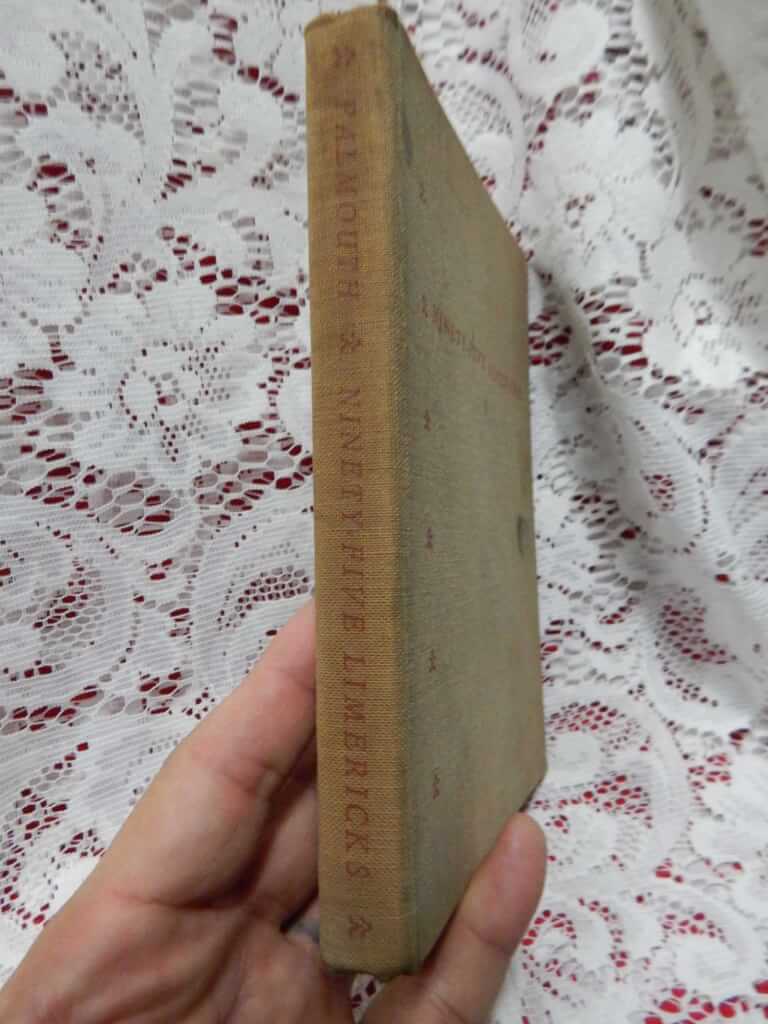
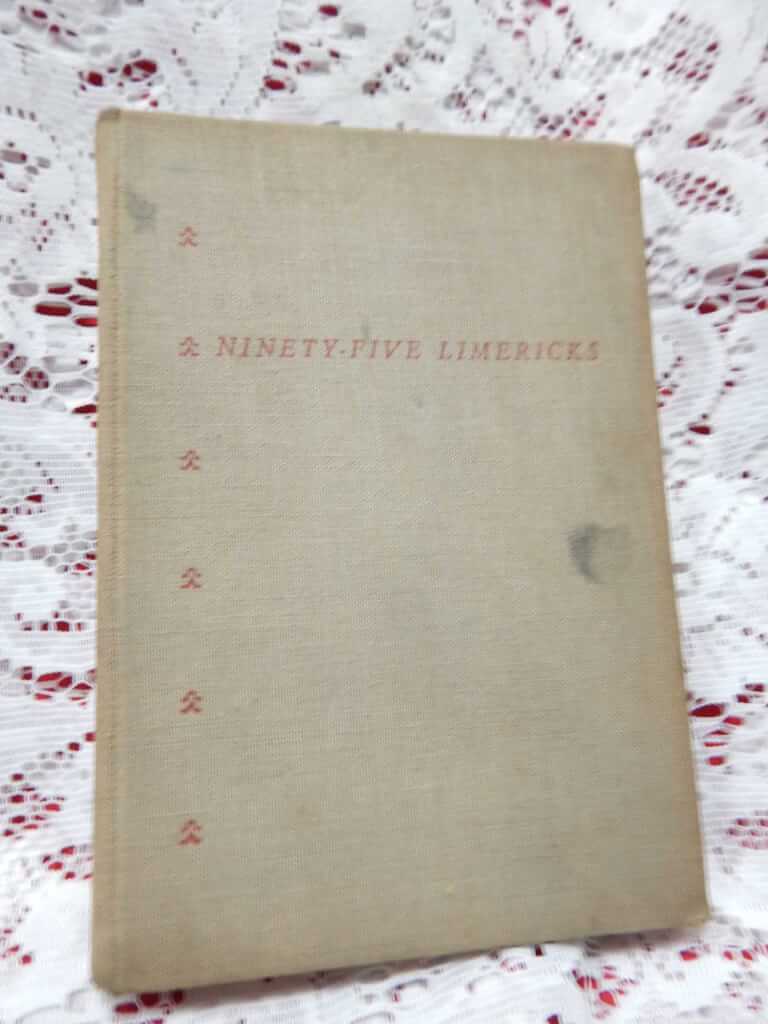 Ninety-Five Limericks | A Contribution to the Folk Lore of our Time | Collected and Edited by John Falmouth (The Limerick Press, Suffern, NY, 1932) 5"x7.25", unpaginated, tan cloth boards with red lettering and decorations, some soiling on boards, interior good, previous owner added a limerick about a young man from Calcutta in the end pages. Mr. Falmouth has a 6 page forward where he discusses the phallic nature of the limerick (with diagrams). A fun little book even though the profanity is exed out.
Ninety-Five Limericks | A Contribution to the Folk Lore of our Time | Collected and Edited by John Falmouth (The Limerick Press, Suffern, NY, 1932) 5"x7.25", unpaginated, tan cloth boards with red lettering and decorations, some soiling on boards, interior good, previous owner added a limerick about a young man from Calcutta in the end pages. Mr. Falmouth has a 6 page forward where he discusses the phallic nature of the limerick (with diagrams). A fun little book even though the profanity is exed out. -
Out of stock

 2.25" x 2.75" Shackle Antique hand-forged iron shackles from a farm in Bulgaria. They have been cleaned up and seasoned much like you'd season your cast iron skillet (repeatedly coated with oil and baked). No key is needed as they lock using a puzzle design.
2.25" x 2.75" Shackle Antique hand-forged iron shackles from a farm in Bulgaria. They have been cleaned up and seasoned much like you'd season your cast iron skillet (repeatedly coated with oil and baked). No key is needed as they lock using a puzzle design. -
Out of stock
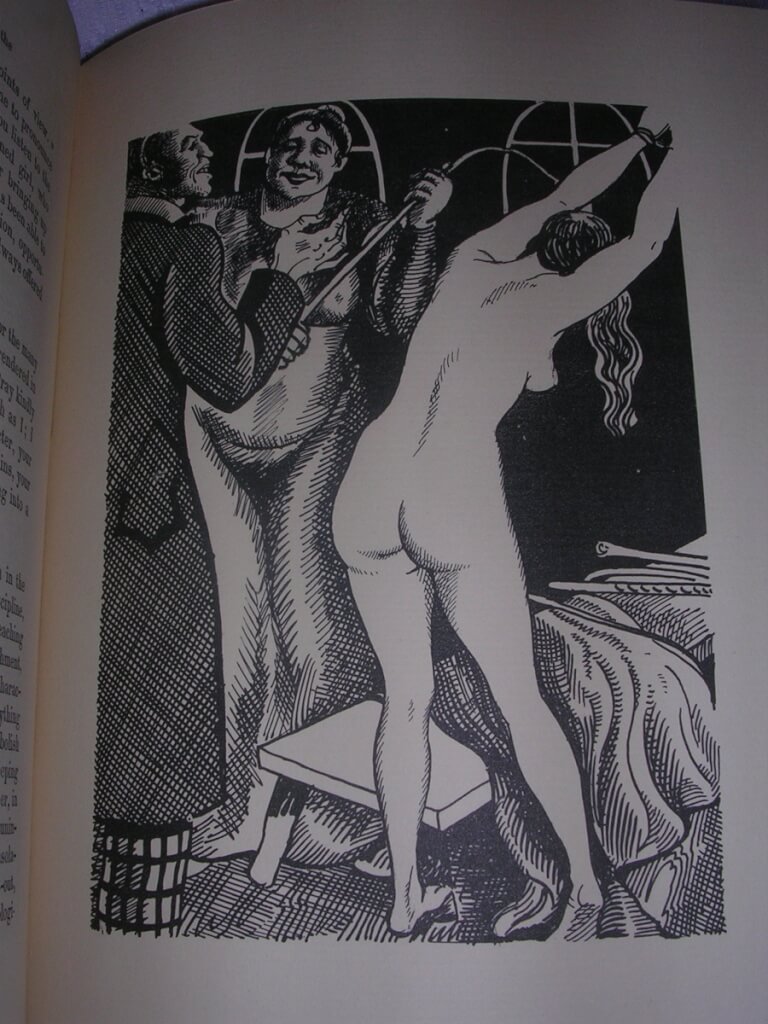 Nell in Bridewell (Lenchen im Zuchthause): Description of the System of Corporal Punishment (Flagellation) in the Female Prisons of South Germany up to the year 1848; a contribution to the history of manners., W. Reinhard, trans. W.C. Costello Ph. D. and A. R. Allinson M. A. (Psych Press [New York], 1932) 9 5/8" X 6 1/2", 326pp, hardbound, black cloth spine over orange cloth boards, gilt lettering and bands on spine, fore and bottom edge deckle, just good condition, soiling and rubbing on front cover, interior clean, some pages unopened, ex libris Joe H. and Bertha M. Shryock Although the title suggests that this is a "study", it goes beyond the facts and delves into the minds of those who are doing the punishing and those who are being humiliated and punished. Publishers of these "flagellation novels" would often lesson their liability by representing their books as academic studies. Often they would go unnoticed by the larger community unaware of the erotic nature of such a book to a certain segment of the public. In this book, Nell describes in graphic terms the merciless floggings she witnessed of girls and young women, as well as of boys and men and confesses to disturbingly confusing emotions that such sights occasioned in her. She recalls the lustful expressions on the faces of the onlookers, records the fervent words of gratitude to the skillful flogger from the lips of grand ladies who "were only too delighted to see such girls whipped", and tells of the evidently sensual appetites such cruelties incited in the torturers. This edition is a facsimile reprint of Carrington's 1900 translation. Added to it are very nice illustrations [woodcuts?] by an unknown artist.
Nell in Bridewell (Lenchen im Zuchthause): Description of the System of Corporal Punishment (Flagellation) in the Female Prisons of South Germany up to the year 1848; a contribution to the history of manners., W. Reinhard, trans. W.C. Costello Ph. D. and A. R. Allinson M. A. (Psych Press [New York], 1932) 9 5/8" X 6 1/2", 326pp, hardbound, black cloth spine over orange cloth boards, gilt lettering and bands on spine, fore and bottom edge deckle, just good condition, soiling and rubbing on front cover, interior clean, some pages unopened, ex libris Joe H. and Bertha M. Shryock Although the title suggests that this is a "study", it goes beyond the facts and delves into the minds of those who are doing the punishing and those who are being humiliated and punished. Publishers of these "flagellation novels" would often lesson their liability by representing their books as academic studies. Often they would go unnoticed by the larger community unaware of the erotic nature of such a book to a certain segment of the public. In this book, Nell describes in graphic terms the merciless floggings she witnessed of girls and young women, as well as of boys and men and confesses to disturbingly confusing emotions that such sights occasioned in her. She recalls the lustful expressions on the faces of the onlookers, records the fervent words of gratitude to the skillful flogger from the lips of grand ladies who "were only too delighted to see such girls whipped", and tells of the evidently sensual appetites such cruelties incited in the torturers. This edition is a facsimile reprint of Carrington's 1900 translation. Added to it are very nice illustrations [woodcuts?] by an unknown artist. -
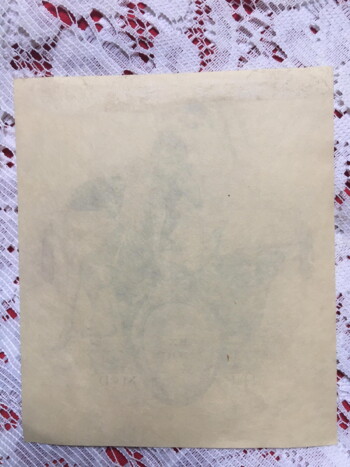
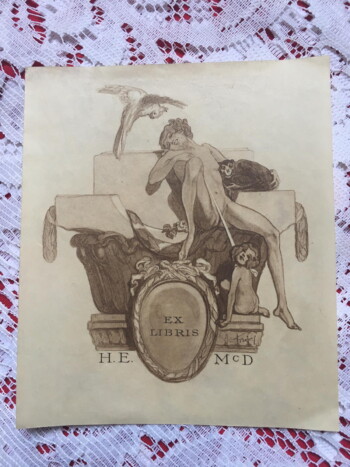 Ex Libris H.E. McD, by Franz von Bayros 4 x 4.5" brown/black ink, previously pasted as evident by top part of back naked girl, animals, and child, presumably Ex libris for Horace E. McDonald Franz von Bayros (1866 – 1924) was an Austrian commercial artist, illustrator, and painter, now he is best known for his erotic work. He belonged to the Decadent movement in art, often utilizing erotic themes and phantasmagoric imagery. At the age 17, Bayros passed the entrance exam for the Vienna Academy with Eduard von Engerth. Bayros mixed in elegant society and soon belonged to the circle of friends of Johann Straub, whose step daughter Alice he married on 1896. The next year, Bayros moved to Munich. In 1904, Bayros gave his first exhibition in Munich, which was a great success. From 1904 until 1908, Bayros traveled to Paris and Italy for his studies. Typically, for an artist dealing with such imagery, von Bayros produced work under several pseudonyms, most notably Choisy Le Conin, and was hounded by authorities for much of his life for his “indecent” art often very imaginative, and including such taboo subjects as sadomasochism and bestiality. He became equally well-known for his masterly drawn figures of elegant modestly nude and non-nude women.
Ex Libris H.E. McD, by Franz von Bayros 4 x 4.5" brown/black ink, previously pasted as evident by top part of back naked girl, animals, and child, presumably Ex libris for Horace E. McDonald Franz von Bayros (1866 – 1924) was an Austrian commercial artist, illustrator, and painter, now he is best known for his erotic work. He belonged to the Decadent movement in art, often utilizing erotic themes and phantasmagoric imagery. At the age 17, Bayros passed the entrance exam for the Vienna Academy with Eduard von Engerth. Bayros mixed in elegant society and soon belonged to the circle of friends of Johann Straub, whose step daughter Alice he married on 1896. The next year, Bayros moved to Munich. In 1904, Bayros gave his first exhibition in Munich, which was a great success. From 1904 until 1908, Bayros traveled to Paris and Italy for his studies. Typically, for an artist dealing with such imagery, von Bayros produced work under several pseudonyms, most notably Choisy Le Conin, and was hounded by authorities for much of his life for his “indecent” art often very imaginative, and including such taboo subjects as sadomasochism and bestiality. He became equally well-known for his masterly drawn figures of elegant modestly nude and non-nude women. -

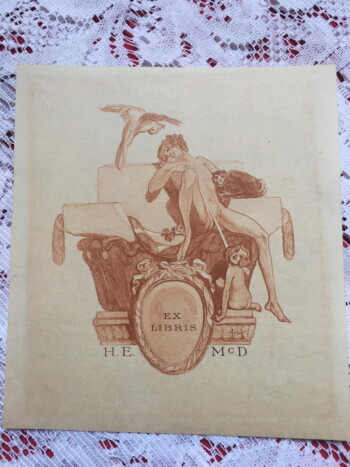 Ex Libris H.E. McD, by Franz von Bayros 4 x 4.5" red ink, previously pasted as evident by top part of back naked girl, animals, and child, presumably Ex libris for Horace E. McDonald Franz von Bayros (1866 – 1924) was an Austrian commercial artist, illustrator, and painter, now he is best known for his erotic work. He belonged to the Decadent movement in art, often utilizing erotic themes and phantasmagoric imagery. At the age 17, Bayros passed the entrance exam for the Vienna Academy with Eduard von Engerth. Bayros mixed in elegant society and soon belonged to the circle of friends of Johann Straub, whose step daughter Alice he married on 1896. The next year, Bayros moved to Munich. In 1904, Bayros gave his first exhibition in Munich, which was a great success. From 1904 until 1908, Bayros traveled to Paris and Italy for his studies. Typically, for an artist dealing with such imagery, von Bayros produced work under several pseudonyms, most notably Choisy Le Conin, and was hounded by authorities for much of his life for his “indecent” art often very imaginative, and including such taboo subjects as sadomasochism and bestiality. He became equally well-known for his masterly drawn figures of elegant modestly nude and non-nude women.
Ex Libris H.E. McD, by Franz von Bayros 4 x 4.5" red ink, previously pasted as evident by top part of back naked girl, animals, and child, presumably Ex libris for Horace E. McDonald Franz von Bayros (1866 – 1924) was an Austrian commercial artist, illustrator, and painter, now he is best known for his erotic work. He belonged to the Decadent movement in art, often utilizing erotic themes and phantasmagoric imagery. At the age 17, Bayros passed the entrance exam for the Vienna Academy with Eduard von Engerth. Bayros mixed in elegant society and soon belonged to the circle of friends of Johann Straub, whose step daughter Alice he married on 1896. The next year, Bayros moved to Munich. In 1904, Bayros gave his first exhibition in Munich, which was a great success. From 1904 until 1908, Bayros traveled to Paris and Italy for his studies. Typically, for an artist dealing with such imagery, von Bayros produced work under several pseudonyms, most notably Choisy Le Conin, and was hounded by authorities for much of his life for his “indecent” art often very imaginative, and including such taboo subjects as sadomasochism and bestiality. He became equally well-known for his masterly drawn figures of elegant modestly nude and non-nude women. -
 Female Masturbation, New Illustrated Edition, G. Lombard Kelly, M.D. (Banner Books, Inglewood, Calif., 1966) 8.75" X 5.25", 192pp, softcover, good+ condition "A complete reprinting of Dr. Kelly's monograph on the subject of female auto-eroticism, as well as articles on the same subject by other well-known doctors including Edwin Hirsch, Bernhard Bauer, A. von Schrench-Notzing, J. Richardson Parke and Albert Moll."
Female Masturbation, New Illustrated Edition, G. Lombard Kelly, M.D. (Banner Books, Inglewood, Calif., 1966) 8.75" X 5.25", 192pp, softcover, good+ condition "A complete reprinting of Dr. Kelly's monograph on the subject of female auto-eroticism, as well as articles on the same subject by other well-known doctors including Edwin Hirsch, Bernhard Bauer, A. von Schrench-Notzing, J. Richardson Parke and Albert Moll." -
 The Golden Ass of Apuleius, Lucius Apuleius Madaurensis (124-170 AD), trans. & intro Francis D. Byrne (The Imperial Press[Charles Carrington?], London, n.d. [1904?]) 8.25" X 6.25", xlix+588pp., hardbound, blue cloth boards with paper label on spine, top edge gilt, other edges deckled, just good condition, tearing to top of spine, no illustrations present. The Metamorphoses of Apuleius, which St. Augustine referred to as “The Golden Ass”, is the only Ancient Roman novel in Latin to survive in its entirety. The plot Lucius and his curiosity and insatiable desire to see and practice magic. While trying to perform a spell to transform into a bird, he is accidentally transformed into an ass. This leads to a long journey, literal and metaphorical, filled with in-set tales. He finally finds salvation through the intervention of the goddess Isis, whose cult he joins. The date of the original work is uncertain. Scholars are not sure if he wrote it in his youth or at the end of his life. He adapted the story from a Greek story written by Lucius of Patrae, however his original Greek text has long been lost.
The Golden Ass of Apuleius, Lucius Apuleius Madaurensis (124-170 AD), trans. & intro Francis D. Byrne (The Imperial Press[Charles Carrington?], London, n.d. [1904?]) 8.25" X 6.25", xlix+588pp., hardbound, blue cloth boards with paper label on spine, top edge gilt, other edges deckled, just good condition, tearing to top of spine, no illustrations present. The Metamorphoses of Apuleius, which St. Augustine referred to as “The Golden Ass”, is the only Ancient Roman novel in Latin to survive in its entirety. The plot Lucius and his curiosity and insatiable desire to see and practice magic. While trying to perform a spell to transform into a bird, he is accidentally transformed into an ass. This leads to a long journey, literal and metaphorical, filled with in-set tales. He finally finds salvation through the intervention of the goddess Isis, whose cult he joins. The date of the original work is uncertain. Scholars are not sure if he wrote it in his youth or at the end of his life. He adapted the story from a Greek story written by Lucius of Patrae, however his original Greek text has long been lost. -
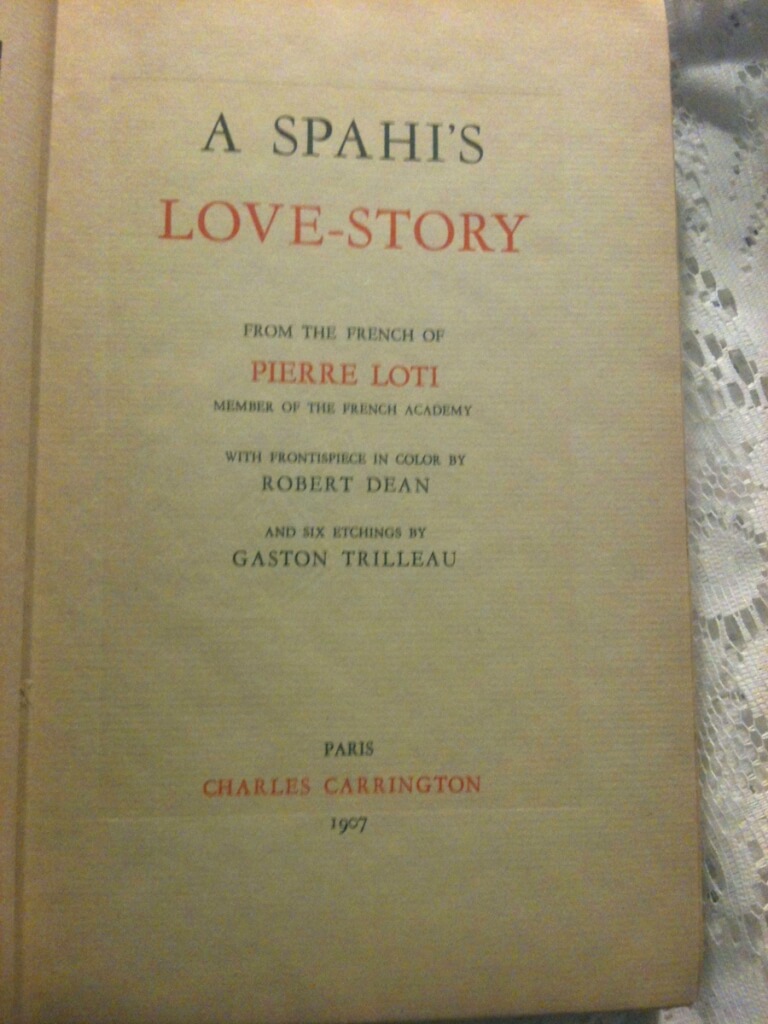
 A Spahi’s Love-Story, Pierre Loti [pseud. Julien Viaud], illus. Robert Dean, illus. Gaston Trilleau (Charles Carrington, Paris, 1907, #17/1000) 9″ x 5.75″, xii+330pp, hardbound, yellow cloth and batik design paper over boards, tipped-in color frontispiece, hand-made paper, deckled edges, good+ condition Julien Viaud (1850-1923) was a French novelist and naval officer. This his third novel (originally titled “Le Roman d’un Spahi”), was originally published in 1881. It recounts the tragic story in the dark middle ages of a Turkish soldier, who fell in love with a woman from a far away culture with a very different background. Color frontispiece by Robert Dean tipped in and six etchings by Gaston Trilleau throughout the book.
A Spahi’s Love-Story, Pierre Loti [pseud. Julien Viaud], illus. Robert Dean, illus. Gaston Trilleau (Charles Carrington, Paris, 1907, #17/1000) 9″ x 5.75″, xii+330pp, hardbound, yellow cloth and batik design paper over boards, tipped-in color frontispiece, hand-made paper, deckled edges, good+ condition Julien Viaud (1850-1923) was a French novelist and naval officer. This his third novel (originally titled “Le Roman d’un Spahi”), was originally published in 1881. It recounts the tragic story in the dark middle ages of a Turkish soldier, who fell in love with a woman from a far away culture with a very different background. Color frontispiece by Robert Dean tipped in and six etchings by Gaston Trilleau throughout the book. -
 Venus in Furs, Leopold von Sacher-Masoch, trans. Fernanda Savage (Privately Printed For Subscirbers Only. 1921, [first english translation?] limited first edition thus, #1045/1225) Venus in Furs (German: Venus im Pelz) is a novella by Leopold Ritter von Sacher-Masoch (1836-1895), an Austrian writer and journalist. It is now his best known work and because of its themes the term masochism is derived from his name, coined by the Austrian psychiatrist, Krafft-Ebing. The novel was to be part of an epic series that Sacher-Masoch envisioned called Legacy of Cain. Venus in Furs was part of Love, the first volume of the series. It was published in 1870. The novel draws themes, like female dominance and sadomasochism, and character inspiration heavily from Sacher-Masoch's own life. Wanda von Dunajew, the novel's central female character, was modelled after his mistress Baroness Fanny Pistor. In December 1869 the two signed a contract making him her slave for a period of 6 months. In 1873, after the publication of Venus in Furs, Sacher-Masoch married Aurora von Rümelin who he pressured to continue the lifestyle he wrote about in his book. After 10 years they divorced. Rümelin, using the pseudonym of the books title character, "Wanda von Dunajew", wrote Meine Lebensbeichte (My Life Confession) published in 1906. It detailed Sacher-Masoch's private life and her relationship with him. During his lifetime, Sacher-Masoch was well known as a man of letters, a utopian thinker who espoused socialist and humanist ideals in his fiction and non-fiction. Most of his works remain untranslated into English. Until recently, his novel Venus in Furs was his only book commonly available in English.
Venus in Furs, Leopold von Sacher-Masoch, trans. Fernanda Savage (Privately Printed For Subscirbers Only. 1921, [first english translation?] limited first edition thus, #1045/1225) Venus in Furs (German: Venus im Pelz) is a novella by Leopold Ritter von Sacher-Masoch (1836-1895), an Austrian writer and journalist. It is now his best known work and because of its themes the term masochism is derived from his name, coined by the Austrian psychiatrist, Krafft-Ebing. The novel was to be part of an epic series that Sacher-Masoch envisioned called Legacy of Cain. Venus in Furs was part of Love, the first volume of the series. It was published in 1870. The novel draws themes, like female dominance and sadomasochism, and character inspiration heavily from Sacher-Masoch's own life. Wanda von Dunajew, the novel's central female character, was modelled after his mistress Baroness Fanny Pistor. In December 1869 the two signed a contract making him her slave for a period of 6 months. In 1873, after the publication of Venus in Furs, Sacher-Masoch married Aurora von Rümelin who he pressured to continue the lifestyle he wrote about in his book. After 10 years they divorced. Rümelin, using the pseudonym of the books title character, "Wanda von Dunajew", wrote Meine Lebensbeichte (My Life Confession) published in 1906. It detailed Sacher-Masoch's private life and her relationship with him. During his lifetime, Sacher-Masoch was well known as a man of letters, a utopian thinker who espoused socialist and humanist ideals in his fiction and non-fiction. Most of his works remain untranslated into English. Until recently, his novel Venus in Furs was his only book commonly available in English. -
 Petting as an Erotic Exercise: a study of the significance and techniques of pre-coital play, D. O. Cauldwell, M.D. (Haldeman-Julius Publications, Girard, Kansas, 1948) 5.5” x 8.5″, 32pp. pamphlet, slight sunning/soiling, very good for age, interior clean. This is one of many books written by David O. Cauldwell (1897-1959), and published by Haldeman-Julius Publications. Dr. Cauldwell was a self-described sexologist who is usually credited with being the first person to use the term 'transsexual' and 'transsexualism'. Although that claim has been widely disputed, he did write some of the first works examining transgender issues. In this pamphlet Dr. Cauldwell writes about foreplay in most all its forms and a call for the normalization of activities that were often described as perversions.
Petting as an Erotic Exercise: a study of the significance and techniques of pre-coital play, D. O. Cauldwell, M.D. (Haldeman-Julius Publications, Girard, Kansas, 1948) 5.5” x 8.5″, 32pp. pamphlet, slight sunning/soiling, very good for age, interior clean. This is one of many books written by David O. Cauldwell (1897-1959), and published by Haldeman-Julius Publications. Dr. Cauldwell was a self-described sexologist who is usually credited with being the first person to use the term 'transsexual' and 'transsexualism'. Although that claim has been widely disputed, he did write some of the first works examining transgender issues. In this pamphlet Dr. Cauldwell writes about foreplay in most all its forms and a call for the normalization of activities that were often described as perversions. -
 Petting as an Erotic Exercise: a study of the significance and techniques of pre-coital play, D. O. Cauldwell, M.D. (Haldeman-Julius Publications, Girard, Kansas, 1948) 5.5” x 8.5″, 32pp. pamphlet, slight sunning/soiling, very good for age, interior clean. This is one of many books written by David O. Cauldwell (1897-1959), and published by Haldeman-Julius Publications. Dr. Cauldwell was a self-described sexologist who is usually credited with being the first person to use the term 'transsexual' and 'transsexualism'. Although that claim has been widely disputed, he did write some of the first works examining transgender issues. In this pamphlet Dr. Cauldwell writes about foreplay in most all its forms and a call for the normalization of activities that were often described as perversions.
Petting as an Erotic Exercise: a study of the significance and techniques of pre-coital play, D. O. Cauldwell, M.D. (Haldeman-Julius Publications, Girard, Kansas, 1948) 5.5” x 8.5″, 32pp. pamphlet, slight sunning/soiling, very good for age, interior clean. This is one of many books written by David O. Cauldwell (1897-1959), and published by Haldeman-Julius Publications. Dr. Cauldwell was a self-described sexologist who is usually credited with being the first person to use the term 'transsexual' and 'transsexualism'. Although that claim has been widely disputed, he did write some of the first works examining transgender issues. In this pamphlet Dr. Cauldwell writes about foreplay in most all its forms and a call for the normalization of activities that were often described as perversions. -
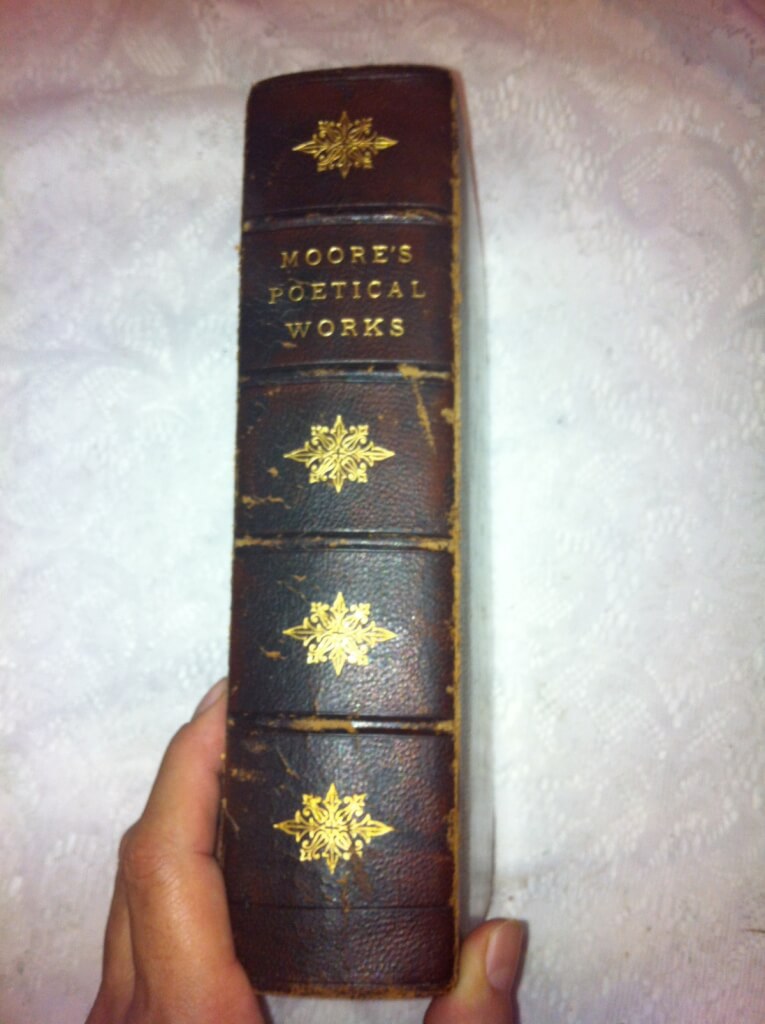
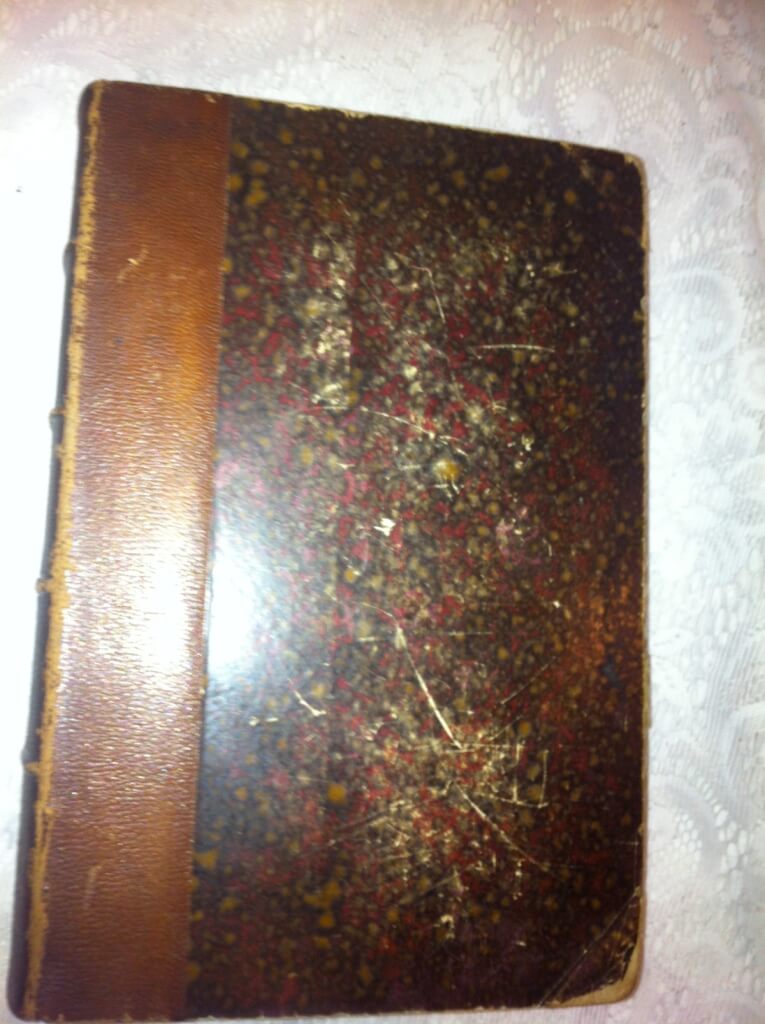 The Poetical Works of Thomas Moore, Thomas Moore (Oliver S. Felt, New York, nd. [c.1860]) 9.5" X 6.5", 776pp., half leather, 4 raised bands. 8 volumes in one. Beautiful steel engravings throughout. Fair condition, binding good, frontispiece missing. Thomas Moore (1779 - 1852) is considered Ireland's "National Bard". He was a poet, singer, songwriter, and entertainer. He was responsible, with John Murray, for burning Lord Byron's memoirs after his death.
The Poetical Works of Thomas Moore, Thomas Moore (Oliver S. Felt, New York, nd. [c.1860]) 9.5" X 6.5", 776pp., half leather, 4 raised bands. 8 volumes in one. Beautiful steel engravings throughout. Fair condition, binding good, frontispiece missing. Thomas Moore (1779 - 1852) is considered Ireland's "National Bard". He was a poet, singer, songwriter, and entertainer. He was responsible, with John Murray, for burning Lord Byron's memoirs after his death. -
 Flagellation & the Flagellants. A History of the Rod in All Countries from the earliest period to the present time, The Rev. Wm. M. Cooper, B.A. [James Glass Bertram] (William Reeves Bookseller Limited, London, nd [c. 1908]) 7 3/4" X 5 1/4", 544pp, hardbound no DJ, dark purple cloth boards with gilt stamp and blind stamp decorations to boards and spine, price is marked on spine in gilt "12/6" (12 shilling, 6 penny), gilting is faded, good condition, minor bumping and rubbing, binding good but leaning slightly, back board hinges worn but holding. Bertram was apprenticed to Tait's Edinburgh Magazine and became managing clerk, before joining a company of strolling players. He returned to Edinburgh and set up as a bookseller and newsagent. In 1855 he was appointed the editor of the North Briton and in 1872 of the Glasgow News, leaving to become a freelance journalist two years later. He published "flagellation" pornography under the names "Revd William Cooper" and "Margaret Anson". This edition was published by William Reeves sometime around 1908.
Flagellation & the Flagellants. A History of the Rod in All Countries from the earliest period to the present time, The Rev. Wm. M. Cooper, B.A. [James Glass Bertram] (William Reeves Bookseller Limited, London, nd [c. 1908]) 7 3/4" X 5 1/4", 544pp, hardbound no DJ, dark purple cloth boards with gilt stamp and blind stamp decorations to boards and spine, price is marked on spine in gilt "12/6" (12 shilling, 6 penny), gilting is faded, good condition, minor bumping and rubbing, binding good but leaning slightly, back board hinges worn but holding. Bertram was apprenticed to Tait's Edinburgh Magazine and became managing clerk, before joining a company of strolling players. He returned to Edinburgh and set up as a bookseller and newsagent. In 1855 he was appointed the editor of the North Briton and in 1872 of the Glasgow News, leaving to become a freelance journalist two years later. He published "flagellation" pornography under the names "Revd William Cooper" and "Margaret Anson". This edition was published by William Reeves sometime around 1908. -
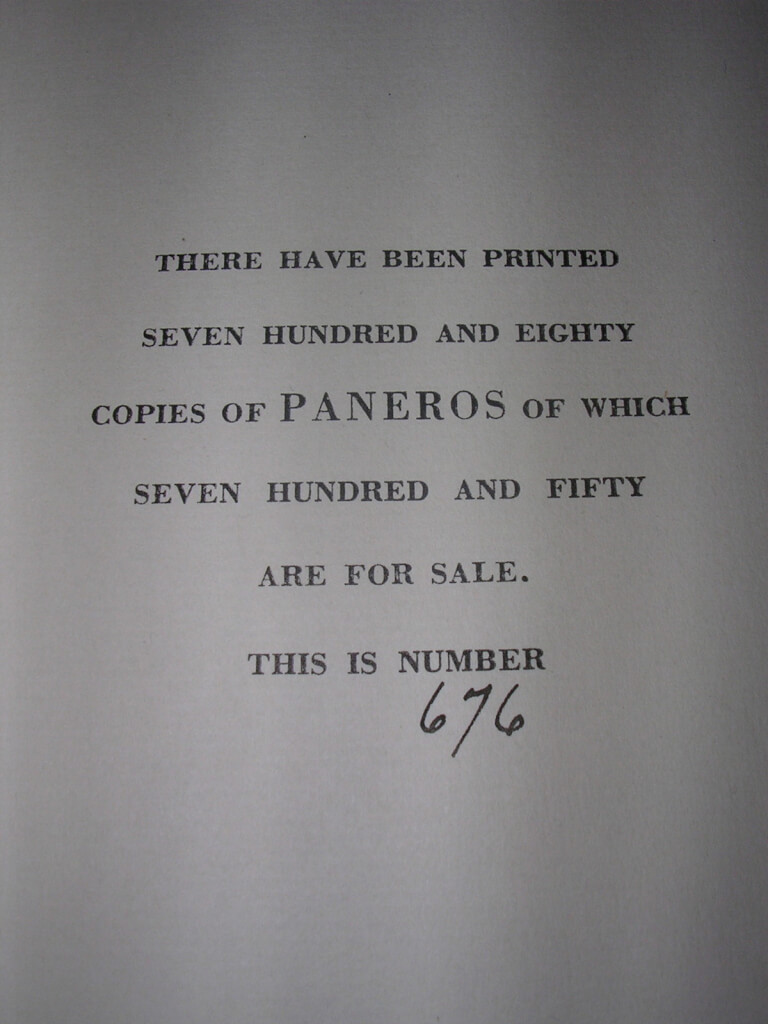
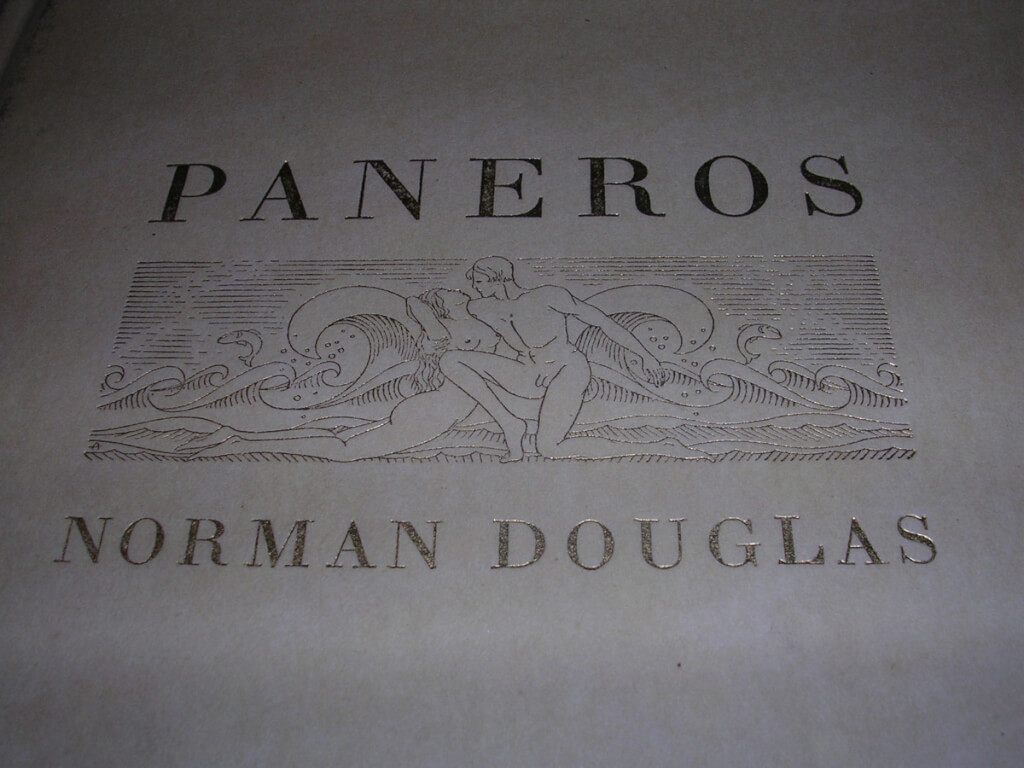 Paneros, some works on aphrodisiacs and the like, Normal Douglas, illus. Robert Rotter [limited, #676/780] (Robert M. McBride & Company, New York, 1932) 9.25" X 5.75", 120pp. Hardcover beige-tan vellum boards with gilt lettering and decorations, top edges gilt. Illustrations throughout. Book in excellent condition, light browning on the spine and edges, it appears to be unread as the binding is tight. #676/780 British author George Norman Douglas (1868 _ 1952) initially published this book in Italy. Doubtless, at the time, had this guide to the world of sexual stimulants been published in London, the author and publisher would have been prosecuted for obscenity. Soon thereafter this limited American version was printed. This edition features an erotic woodcut frontis, other illustrations by Robert Rotter and was limited to 780 copies. Hard to find book with an even harder to find slipcase. Interesting and beautifully illustrated.
Paneros, some works on aphrodisiacs and the like, Normal Douglas, illus. Robert Rotter [limited, #676/780] (Robert M. McBride & Company, New York, 1932) 9.25" X 5.75", 120pp. Hardcover beige-tan vellum boards with gilt lettering and decorations, top edges gilt. Illustrations throughout. Book in excellent condition, light browning on the spine and edges, it appears to be unread as the binding is tight. #676/780 British author George Norman Douglas (1868 _ 1952) initially published this book in Italy. Doubtless, at the time, had this guide to the world of sexual stimulants been published in London, the author and publisher would have been prosecuted for obscenity. Soon thereafter this limited American version was printed. This edition features an erotic woodcut frontis, other illustrations by Robert Rotter and was limited to 780 copies. Hard to find book with an even harder to find slipcase. Interesting and beautifully illustrated. -
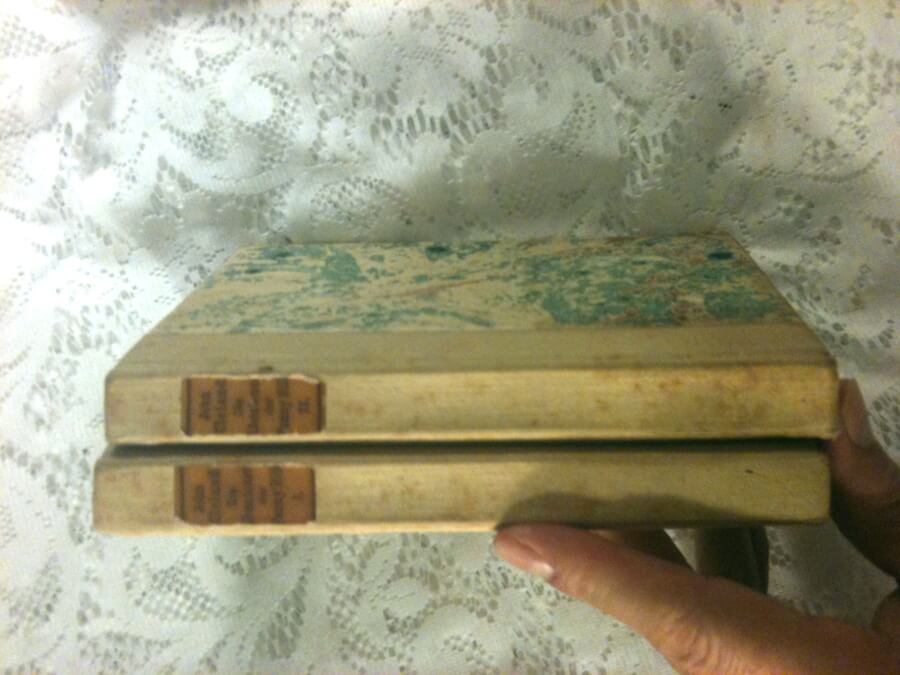
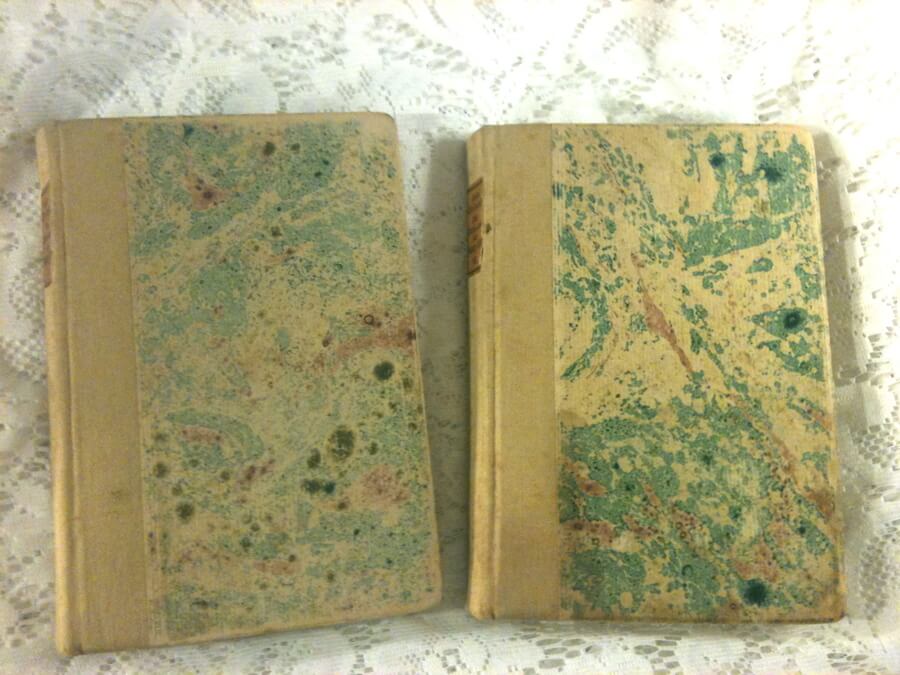 Die Abenteuer der Fanny Hill, John Cleland (np, München, 1919) 7.25" x 5", 2 vol., 178pp, 179-370pp, hardbound, marbled paper boards with cloth spine. Paper label on spine. Good condition for age, showing wear at hinges, both slightly cocked, pages yellowing. Boards worn at edges and corners Written while the author was in debtor's prison in London and first published in 1749, Fanny Hill is considered the first original English prose pornography, and the first pornography to use the form of the novel. One of the most prosecuted and banned books in history, it has become a synonym for obscenity. This German version of Fanny Hill is without mention of publisher. This was German "Bückware" or an item that was kept under the counter only for customers who asked for it. A nice 2 volume set in German.
Die Abenteuer der Fanny Hill, John Cleland (np, München, 1919) 7.25" x 5", 2 vol., 178pp, 179-370pp, hardbound, marbled paper boards with cloth spine. Paper label on spine. Good condition for age, showing wear at hinges, both slightly cocked, pages yellowing. Boards worn at edges and corners Written while the author was in debtor's prison in London and first published in 1749, Fanny Hill is considered the first original English prose pornography, and the first pornography to use the form of the novel. One of the most prosecuted and banned books in history, it has become a synonym for obscenity. This German version of Fanny Hill is without mention of publisher. This was German "Bückware" or an item that was kept under the counter only for customers who asked for it. A nice 2 volume set in German. -
Out of stock
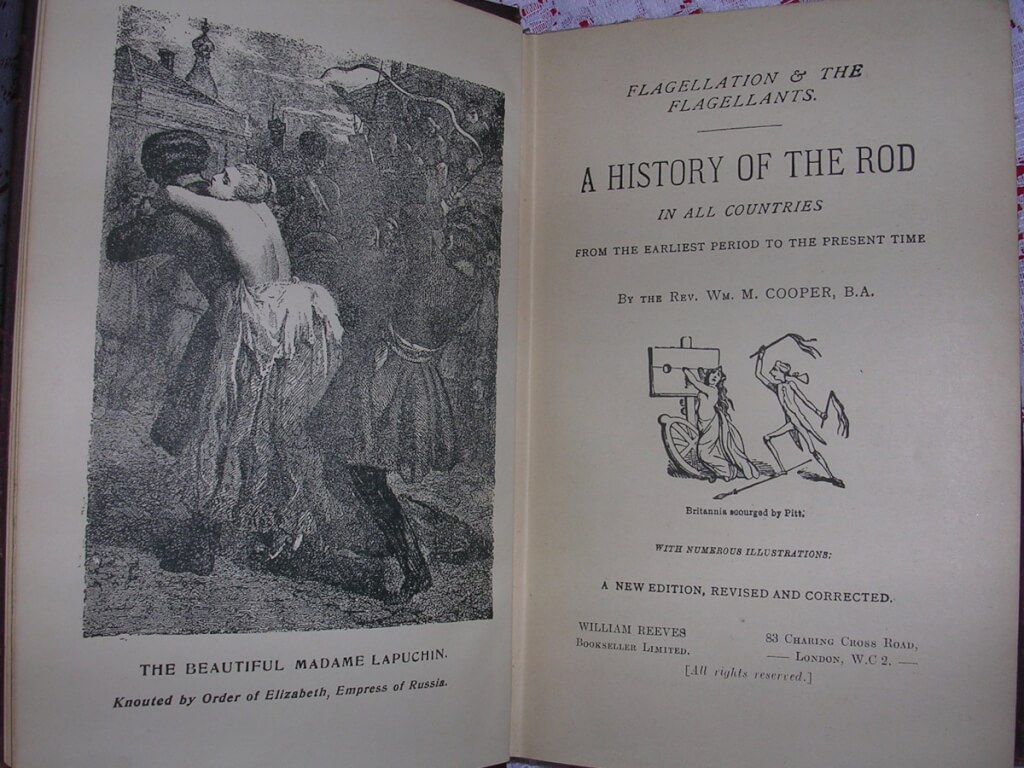
 Flagellation & the Flagellants. A History of the Rod in All Countries from the earliest period to the present time, The Rev. Wm. M. Cooper, B.A. [James Glass Bertram] (William Reeves Bookseller Limited, London, nd [c. 1908]) 7 3/4" X 5 1/4", 544pp, hardbound no DJ, dark purple cloth boards with gilt stamp and blind stamp decorations to boards and spine, good condition, minor bumping and rubbing, a few stains on lower fore-edge of boards. Bertram was apprenticed to Tait's Edinburgh Magazine and became managing clerk, before joining a company of strolling players. He returned to Edinburgh and set up as a bookseller and newsagent. In 1855 he was appointed the editor of the North Briton and in 1872 of the Glasgow News, leaving to become a freelance journalist two years later. He published "flagellation" pornography under the names "Revd William Cooper" and "Margaret Anson". This edition was published by William Reeves sometime around 1908.
Flagellation & the Flagellants. A History of the Rod in All Countries from the earliest period to the present time, The Rev. Wm. M. Cooper, B.A. [James Glass Bertram] (William Reeves Bookseller Limited, London, nd [c. 1908]) 7 3/4" X 5 1/4", 544pp, hardbound no DJ, dark purple cloth boards with gilt stamp and blind stamp decorations to boards and spine, good condition, minor bumping and rubbing, a few stains on lower fore-edge of boards. Bertram was apprenticed to Tait's Edinburgh Magazine and became managing clerk, before joining a company of strolling players. He returned to Edinburgh and set up as a bookseller and newsagent. In 1855 he was appointed the editor of the North Briton and in 1872 of the Glasgow News, leaving to become a freelance journalist two years later. He published "flagellation" pornography under the names "Revd William Cooper" and "Margaret Anson". This edition was published by William Reeves sometime around 1908. -
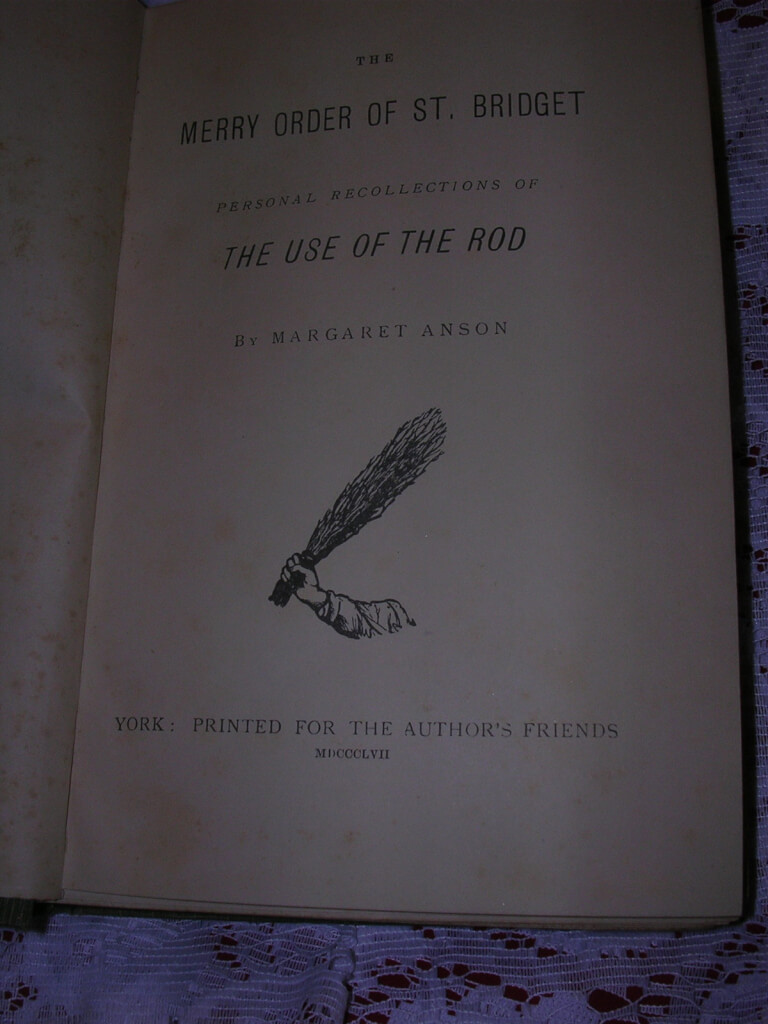
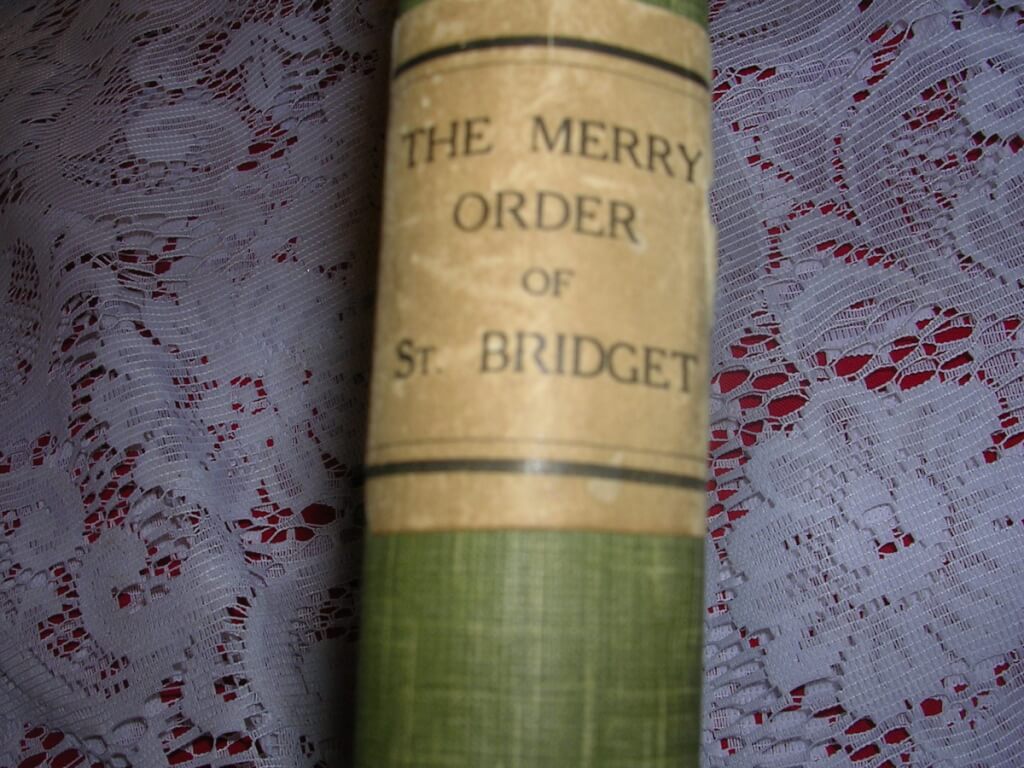 The Merry Order of St. Bridget, Margaret Anson (James Glass Bertram) (Printed for the Author's Friends, np, York, 1857 [fascimile copy of the 1868 edition c. 1930]) 7 7/8" X 5 1/4", 237pp, hardbound textured green cloth boards, paper lable on spine, deckle edges, corners and top/botton of spine bumped, binding loose but intact Bertram was apprenticed to Tait's Edinburgh Magazine and became managing clerk, before joining a company of strolling players. He returned to Edinburgh and set up as a bookseller and newsagent. In 1855 he was appointed the editor of the North Briton and in 1872 of the Glasgow News, leaving to become a freelance journalist two years later. He published "flagellation" pornography under the names "Revd William Cooper" and "Margaret Anson". In this graphic unveiling of 19th-century sexual adventures, Margaret Anson, a submissive handmaiden to the notorious Marquise St. Val_ry, describes the orgies at the Chateau de Floris, where the elite women of Paris submit to the subjugations and exotic indignities of the flesh that trigger ecstatic sensations. "Do you remember how we used to indulge in whipping on the sly, when Madame thought we were in bed? That was a very untutored way of proceeding. I have learned better since, and I can tell you that the passion for the rod is one which grows." 237 pp.
The Merry Order of St. Bridget, Margaret Anson (James Glass Bertram) (Printed for the Author's Friends, np, York, 1857 [fascimile copy of the 1868 edition c. 1930]) 7 7/8" X 5 1/4", 237pp, hardbound textured green cloth boards, paper lable on spine, deckle edges, corners and top/botton of spine bumped, binding loose but intact Bertram was apprenticed to Tait's Edinburgh Magazine and became managing clerk, before joining a company of strolling players. He returned to Edinburgh and set up as a bookseller and newsagent. In 1855 he was appointed the editor of the North Briton and in 1872 of the Glasgow News, leaving to become a freelance journalist two years later. He published "flagellation" pornography under the names "Revd William Cooper" and "Margaret Anson". In this graphic unveiling of 19th-century sexual adventures, Margaret Anson, a submissive handmaiden to the notorious Marquise St. Val_ry, describes the orgies at the Chateau de Floris, where the elite women of Paris submit to the subjugations and exotic indignities of the flesh that trigger ecstatic sensations. "Do you remember how we used to indulge in whipping on the sly, when Madame thought we were in bed? That was a very untutored way of proceeding. I have learned better since, and I can tell you that the passion for the rod is one which grows." 237 pp. -
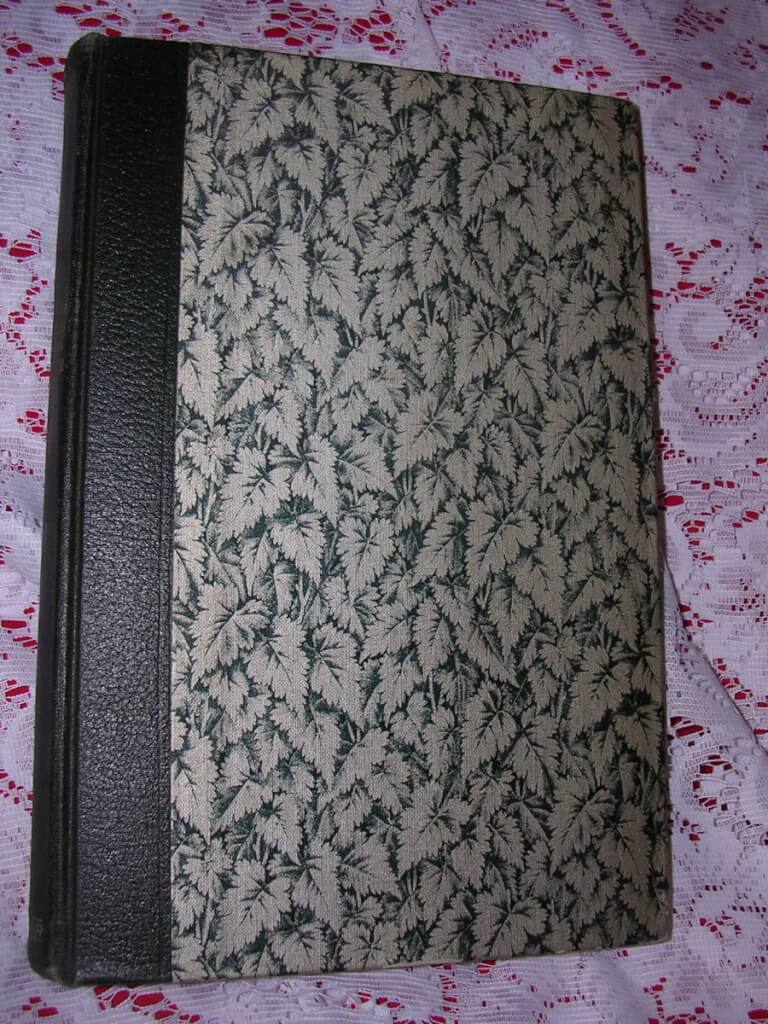
 Amatory Adventures of Sheik Mansour, A Master of the Art of Love, Hector France (Jul-Mar Press, 1932) 6 3/8 x 9 5/8", 249 pp, Stated, limited printing of 1000, but has no number. By Hector France, illustrated by Esaye Rabkin, this is a nice copy of this classic erotic novel. Book is a good used copy - cover is nice, has some rubbing to corners, overall age/use, as seen in the photo. Pages are all present and bound solid. Book has two 'Discarded' stamps, one at inside of the front cover, one at the title page. Has a damp stain along bottom margin of pages from front to page 19, small chip and tear at bottom of the title page. I see no other extraneous marks in this copy! Hector France (1837 - 1908) was a French author best known for his "orientalist" and flagellation tales. This is his risque tale of an Arab stud in action; a novel set around a Turkish harem. Translated by Alfred Allinson and reproduced from the Charles Carrington novel "The Chastisement of Mansour"
Amatory Adventures of Sheik Mansour, A Master of the Art of Love, Hector France (Jul-Mar Press, 1932) 6 3/8 x 9 5/8", 249 pp, Stated, limited printing of 1000, but has no number. By Hector France, illustrated by Esaye Rabkin, this is a nice copy of this classic erotic novel. Book is a good used copy - cover is nice, has some rubbing to corners, overall age/use, as seen in the photo. Pages are all present and bound solid. Book has two 'Discarded' stamps, one at inside of the front cover, one at the title page. Has a damp stain along bottom margin of pages from front to page 19, small chip and tear at bottom of the title page. I see no other extraneous marks in this copy! Hector France (1837 - 1908) was a French author best known for his "orientalist" and flagellation tales. This is his risque tale of an Arab stud in action; a novel set around a Turkish harem. Translated by Alfred Allinson and reproduced from the Charles Carrington novel "The Chastisement of Mansour" -
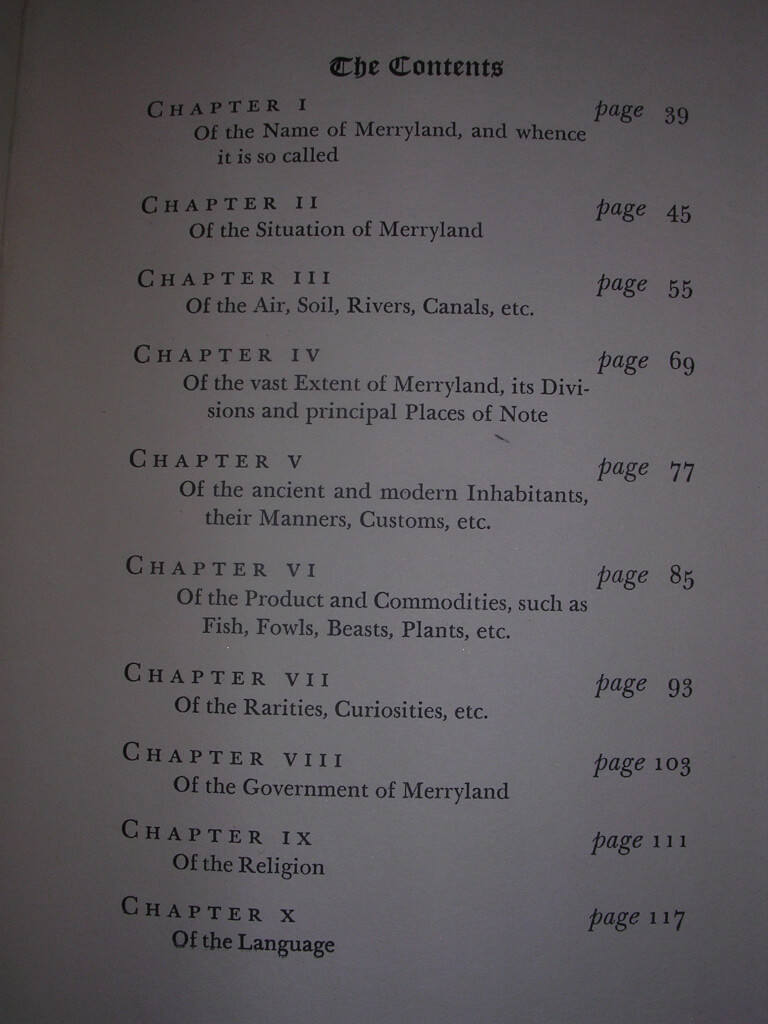
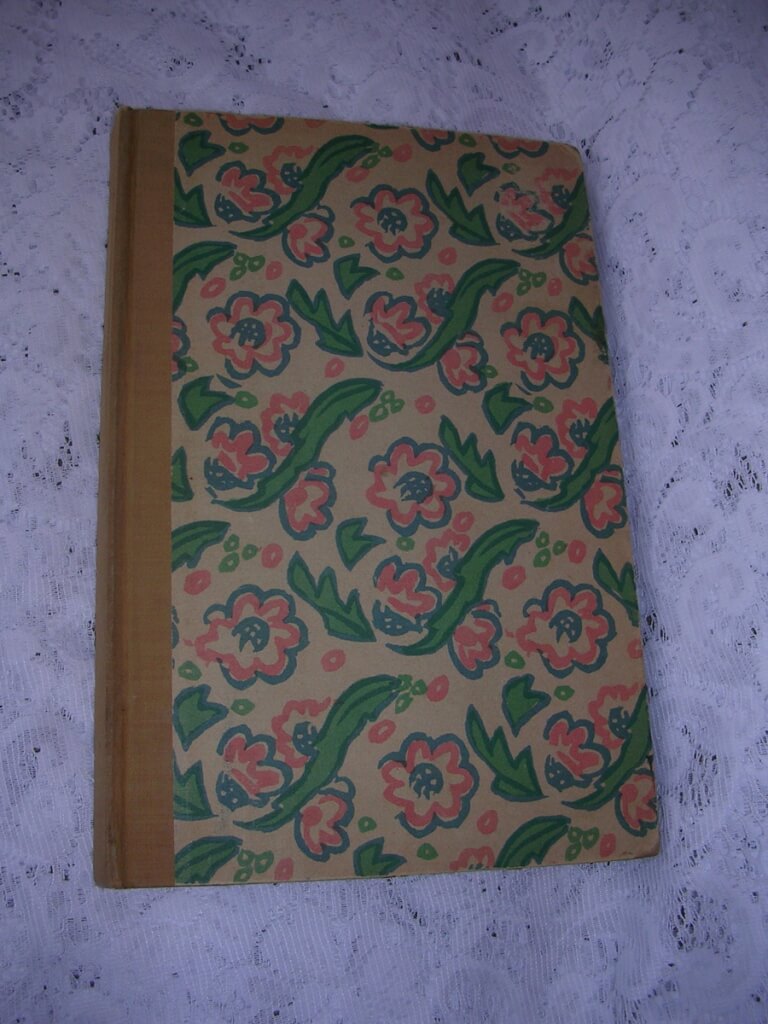 Merryland, Thomas Stretzer (Privately Issued, New York, Robin Hood House, 1932) 9 3/8" X 6 1/4", 136pp, hardbound no DJ, decorative paper boards with mylar protector, flower design, gilt lettering on spine, very good condition The Merryland books were a somewhat peculiar genre of English seventeenth and eighteenth century erotic fiction in which the female body was described in terms of a topographical metaphor derived from a pun on Maryland. Stretzer's book is typical of the genre in depicting the female body as a landscape that men explore, till, and plow. For example, he writes: "Her valleys are like Eden, her hills like Lebanon, she is a paradise of pleasure and a garden of delight."
Merryland, Thomas Stretzer (Privately Issued, New York, Robin Hood House, 1932) 9 3/8" X 6 1/4", 136pp, hardbound no DJ, decorative paper boards with mylar protector, flower design, gilt lettering on spine, very good condition The Merryland books were a somewhat peculiar genre of English seventeenth and eighteenth century erotic fiction in which the female body was described in terms of a topographical metaphor derived from a pun on Maryland. Stretzer's book is typical of the genre in depicting the female body as a landscape that men explore, till, and plow. For example, he writes: "Her valleys are like Eden, her hills like Lebanon, she is a paradise of pleasure and a garden of delight." -
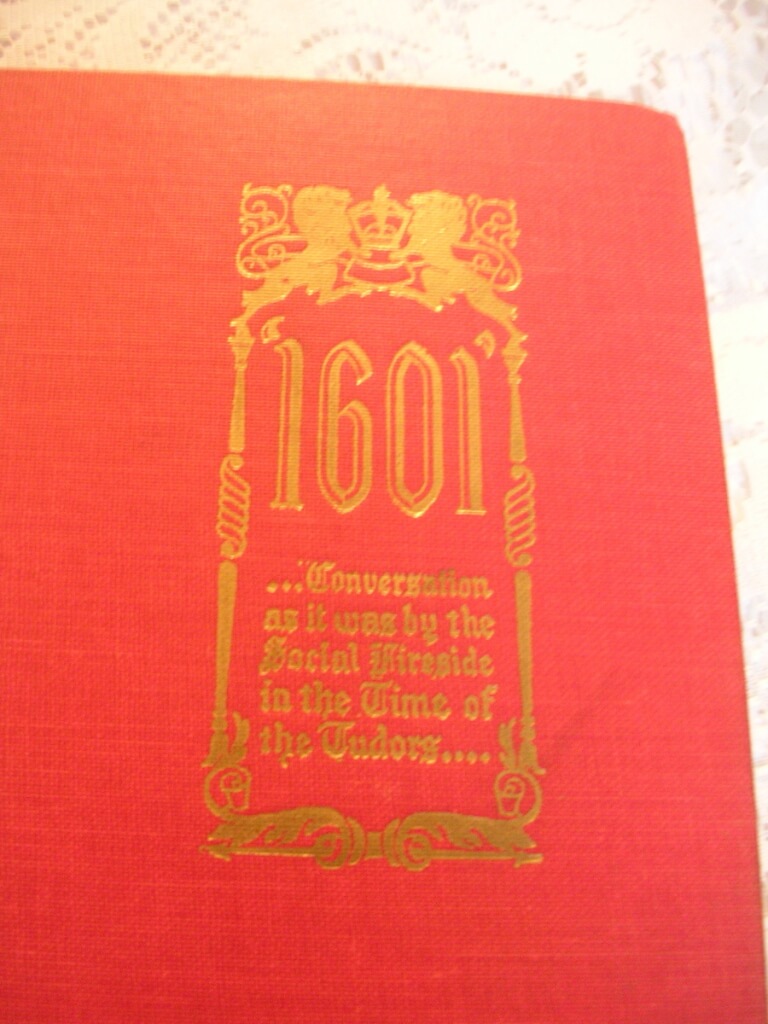
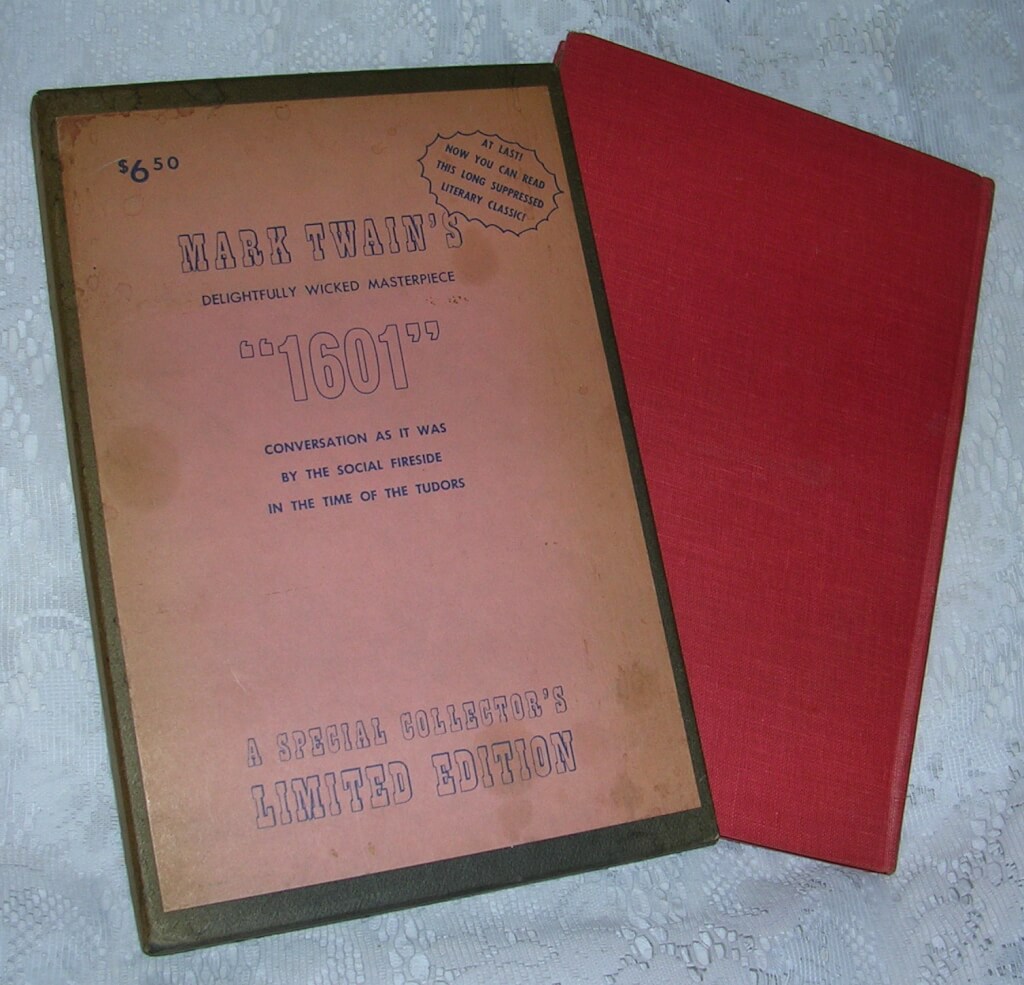 Mark Twain's [Date, 1601.] Conversation As it was by the Social Fireside in the Time of the Tudors, Mark Twain, "With an Illuminating Introduction, Facetions Footnotes and a Bibliography by Franklin J. Meine" (Privately Printed for Lyle Stuart, New York, nd [c. 1939]) 9 1/2" X 6 1/4", 80pp, hardbound no DJ with slipcase, red cloth boards with gilt lettering and decoration, book very good condition, slight soiling on spine, slipcover good condition, faded spine and soiled but intact [Date: 1601.] Conversation, as it was the Social Fireside, in the Time of the Tudors is the title of a humorous work by Mark Twain, first published anonymously in 1880. Edward Wagenknecht once referred to it as "the most famous piece of pornography in American literature." Its content is irreverent and vulgar rather than obscene, and its purpose seems to be comedic shock rather than erotic arousal. It would thus qualify as ribaldry rather than pornography. Twain wrote 1601 during the summer of 1876 (between writing Tom Sawyer and Huckleberry Finn), for the amusement of his closest friend, Reverend Joseph Twichell, 1601 was later first published by another friend, John Hay, who later became Secretary of State. The work circulated among printers (due to it's often archaic type font) and many small batches were printed, however the authorship of the work remained unverified until Twain finally acknowledged he wrote it in 1906.
Mark Twain's [Date, 1601.] Conversation As it was by the Social Fireside in the Time of the Tudors, Mark Twain, "With an Illuminating Introduction, Facetions Footnotes and a Bibliography by Franklin J. Meine" (Privately Printed for Lyle Stuart, New York, nd [c. 1939]) 9 1/2" X 6 1/4", 80pp, hardbound no DJ with slipcase, red cloth boards with gilt lettering and decoration, book very good condition, slight soiling on spine, slipcover good condition, faded spine and soiled but intact [Date: 1601.] Conversation, as it was the Social Fireside, in the Time of the Tudors is the title of a humorous work by Mark Twain, first published anonymously in 1880. Edward Wagenknecht once referred to it as "the most famous piece of pornography in American literature." Its content is irreverent and vulgar rather than obscene, and its purpose seems to be comedic shock rather than erotic arousal. It would thus qualify as ribaldry rather than pornography. Twain wrote 1601 during the summer of 1876 (between writing Tom Sawyer and Huckleberry Finn), for the amusement of his closest friend, Reverend Joseph Twichell, 1601 was later first published by another friend, John Hay, who later became Secretary of State. The work circulated among printers (due to it's often archaic type font) and many small batches were printed, however the authorship of the work remained unverified until Twain finally acknowledged he wrote it in 1906. -

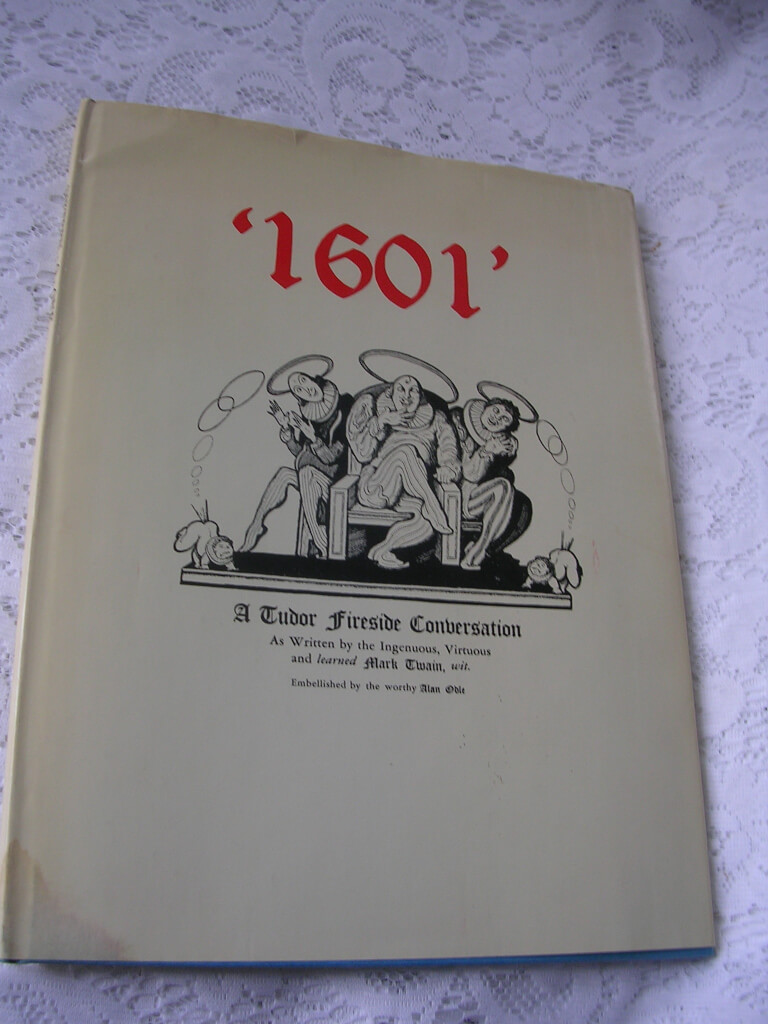 1601 A Tudor Fireside Conversation As Written by the Ingenuous, Virtuous and learned Mark Twain, wit., Embellished by the worthy Alan Odle, Mark Twain, illustrations Alan Odle (Land's End Press, USA, 1969, stated "At London, Printed for Subscribers Only and are to be sold at ye beare Back-Side in Maiden Lane") 12 1/2" X 9 1/2", 24pp (unpaginated), hardbound with dust jacket, blue boards with blue titles, pages, pages printed in such a way that the lower edge is uncut (six folded sheets of paper printed on one side, making up 4 pages) [Date: 1601.] Conversation, as it was the Social Fireside, in the Time of the Tudors is the title of a humorous work by Mark Twain, first published anonymously in 1880. Edward Wagenknecht once referred to it as "the most famous piece of pornography in American literature." Its content is irreverent and vulgar rather than obscene, and its purpose seems to be comedic shock rather than erotic arousal. It would thus qualify as ribaldry rather than pornography. Twain wrote 1601 during the summer of 1876 (between writing Tom Sawyer and Huckleberry Finn), for the amusement of his closest friend, Reverend Joseph Twichell, 1601 was later first published by another friend, John Hay, who later became Secretary of State. The work circulated among printers (due to it's often archaic type font) and many small batches were printed, however the authorship of the work remained unverified until Twain finally acknowledged he wrote it in 1906.
1601 A Tudor Fireside Conversation As Written by the Ingenuous, Virtuous and learned Mark Twain, wit., Embellished by the worthy Alan Odle, Mark Twain, illustrations Alan Odle (Land's End Press, USA, 1969, stated "At London, Printed for Subscribers Only and are to be sold at ye beare Back-Side in Maiden Lane") 12 1/2" X 9 1/2", 24pp (unpaginated), hardbound with dust jacket, blue boards with blue titles, pages, pages printed in such a way that the lower edge is uncut (six folded sheets of paper printed on one side, making up 4 pages) [Date: 1601.] Conversation, as it was the Social Fireside, in the Time of the Tudors is the title of a humorous work by Mark Twain, first published anonymously in 1880. Edward Wagenknecht once referred to it as "the most famous piece of pornography in American literature." Its content is irreverent and vulgar rather than obscene, and its purpose seems to be comedic shock rather than erotic arousal. It would thus qualify as ribaldry rather than pornography. Twain wrote 1601 during the summer of 1876 (between writing Tom Sawyer and Huckleberry Finn), for the amusement of his closest friend, Reverend Joseph Twichell, 1601 was later first published by another friend, John Hay, who later became Secretary of State. The work circulated among printers (due to it's often archaic type font) and many small batches were printed, however the authorship of the work remained unverified until Twain finally acknowledged he wrote it in 1906. -

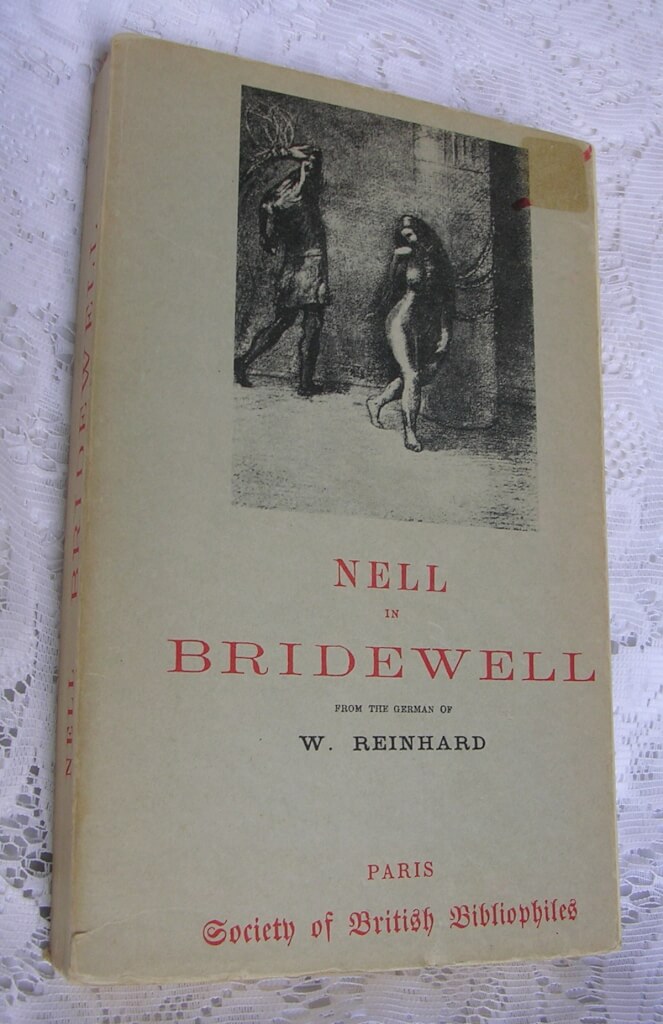 Nell in Bridewell (Lenchen im Zuchthause), W. Reinhard, trans. W.C. Costello Ph. D. and A. R. Allinson M. A. (Society of British Bibliophiles, Paris, 1900) 8" X 5", 326pp, paperback, good condition, price tag mark on front cover, a tear and some bumping, spine is creased, binding is still good Subtitle: "Description of the System of Corporal Punishment (Flagellation) in the Female Prisons of South Germany up to the year 1848; a contribution to the history of manners." Although the title suggests that this is a "study", it goes beyond the facts and delves into the minds of those who are doing the punishing and those who are being humiliated and punished. Publishers of these "flagellation novels" would often lesson their liability by representing their books as academic studies. Often they would go unnoticed by the larger community unaware of the erotic nature of such a book to a certain segment of the public. In this book, Nell describes in graphic terms the merciless floggings she witnessed of girls and young women, as well as of boys and men and confesses to disturbingly confusing emotions that such sights occasioned in her. She recalls the lustful expressions on the faces of the onlookers, records the fervent words of gratitude to the skillful flogger from the lips of grand ladies who "were only too delighted to see such girls whipped", and tells of the evidently sensual appetites such cruelties incited in the torturers.
Nell in Bridewell (Lenchen im Zuchthause), W. Reinhard, trans. W.C. Costello Ph. D. and A. R. Allinson M. A. (Society of British Bibliophiles, Paris, 1900) 8" X 5", 326pp, paperback, good condition, price tag mark on front cover, a tear and some bumping, spine is creased, binding is still good Subtitle: "Description of the System of Corporal Punishment (Flagellation) in the Female Prisons of South Germany up to the year 1848; a contribution to the history of manners." Although the title suggests that this is a "study", it goes beyond the facts and delves into the minds of those who are doing the punishing and those who are being humiliated and punished. Publishers of these "flagellation novels" would often lesson their liability by representing their books as academic studies. Often they would go unnoticed by the larger community unaware of the erotic nature of such a book to a certain segment of the public. In this book, Nell describes in graphic terms the merciless floggings she witnessed of girls and young women, as well as of boys and men and confesses to disturbingly confusing emotions that such sights occasioned in her. She recalls the lustful expressions on the faces of the onlookers, records the fervent words of gratitude to the skillful flogger from the lips of grand ladies who "were only too delighted to see such girls whipped", and tells of the evidently sensual appetites such cruelties incited in the torturers. -
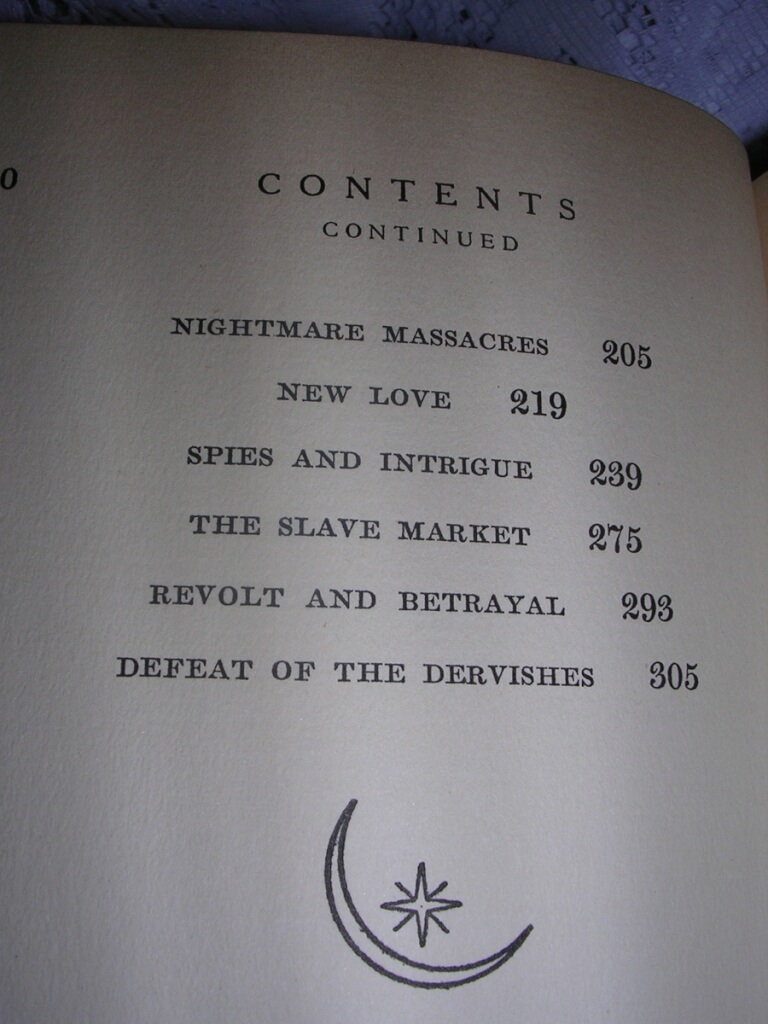
 Black Lust, Jean de Villiot [George Grassal (Hugues Rebell)] (Privately printed by The Panurge Press, Inc., New York, 1931, #365/2000) 8 5/8" X 6", 312pp, hardbound no DJ, cream cloth boards with black stamped decorations, top edge dyed blue, other edges deckle, good condition, slight soiling to boards, binding tight Jean de Villiot was a pseudonym used by several authors and compilers working for the publisher Charles Carrington writing novels and "studies" concerning flagellation, including Hugues Rebell (Georges Grassal), Hector France, Stéphane Arnoulin and Charles Carrington, himself. This novel is attributed to George Grassal (Hugues Rebell) originally written in French, in 1902, as "La Femme et son maître" (The Woman and her Master). In 1904 "Woman and her Master" was published in English by Charles Carrington. Panurge Press published this work as "Black Lust" in 1931. This book is a numbered limited edition copy of the Panurge Press edition.
Black Lust, Jean de Villiot [George Grassal (Hugues Rebell)] (Privately printed by The Panurge Press, Inc., New York, 1931, #365/2000) 8 5/8" X 6", 312pp, hardbound no DJ, cream cloth boards with black stamped decorations, top edge dyed blue, other edges deckle, good condition, slight soiling to boards, binding tight Jean de Villiot was a pseudonym used by several authors and compilers working for the publisher Charles Carrington writing novels and "studies" concerning flagellation, including Hugues Rebell (Georges Grassal), Hector France, Stéphane Arnoulin and Charles Carrington, himself. This novel is attributed to George Grassal (Hugues Rebell) originally written in French, in 1902, as "La Femme et son maître" (The Woman and her Master). In 1904 "Woman and her Master" was published in English by Charles Carrington. Panurge Press published this work as "Black Lust" in 1931. This book is a numbered limited edition copy of the Panurge Press edition. -
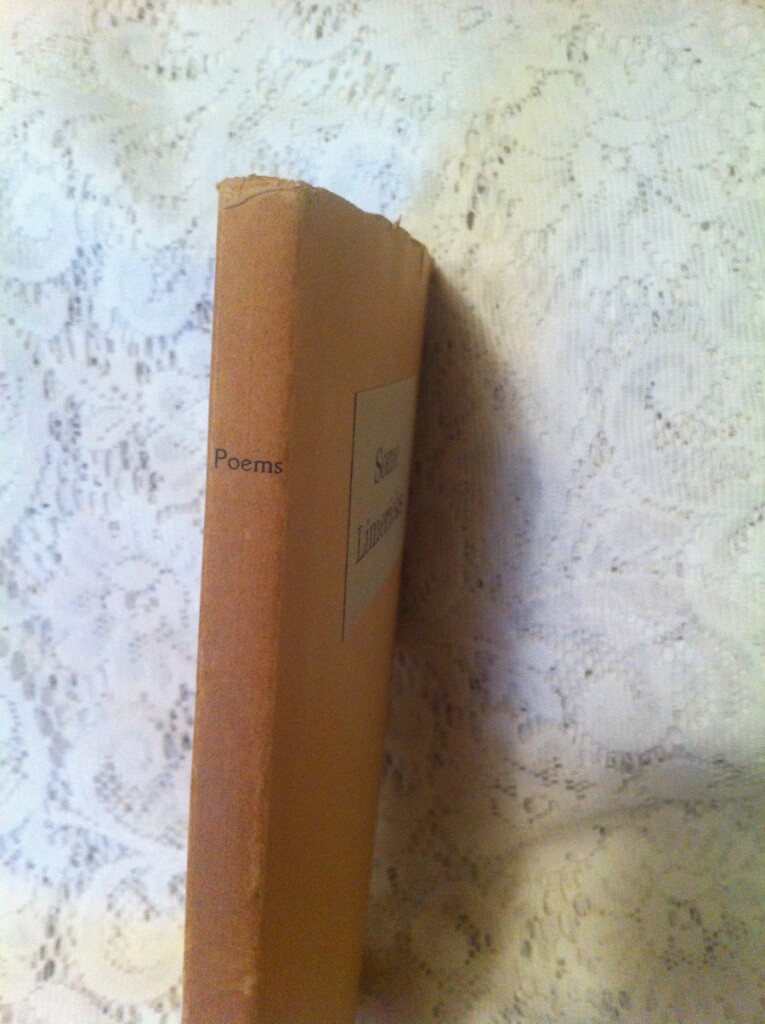
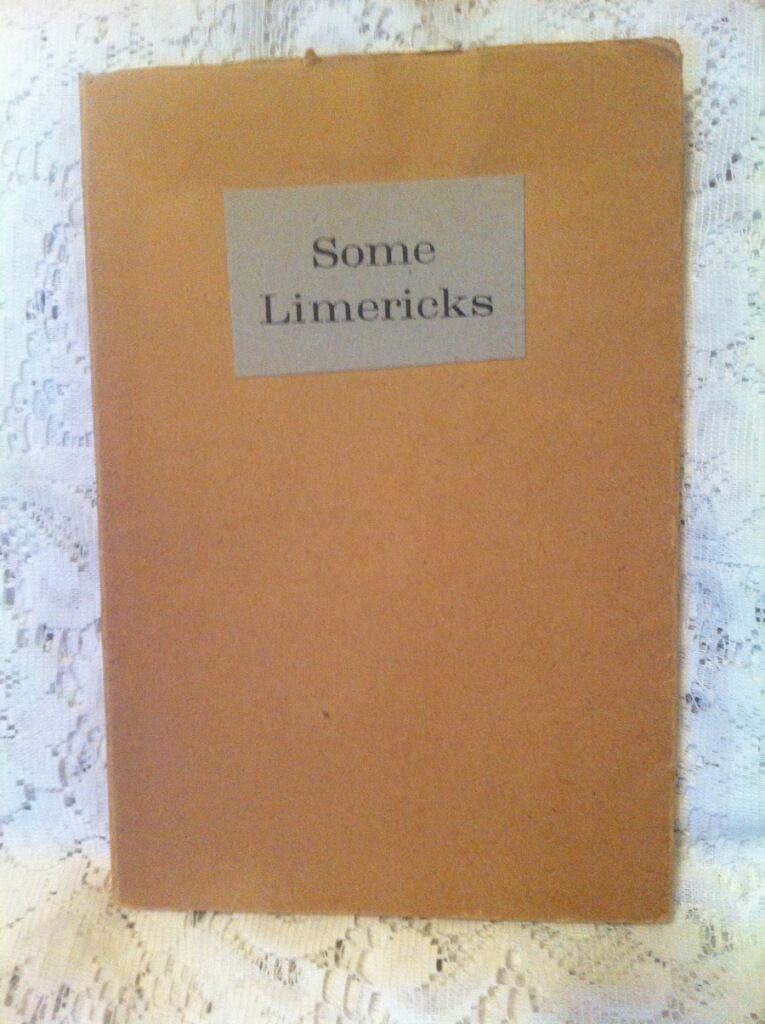 Some Limericks: Collected for the use of Students, & ensplendour’d with Introduction, Geographical Index, and with Notes Explanatory and Critical, by Norman Douglas (Nicholson and Whitney, Boston, 1942 [most likely published in Paris by Maurice Girodias of Olympia Press, early 1950's, a reprint of the Obelisk Press edition of 1939], stated 616/1000 "printed by The Brownbent Press, Boston, Mass.") 5.5" x 8.25", 117pp, near fine condition, unlabeled soft covers, dust jacket slightly warn at top with paper label "Some Limericks", spine of dust jacket simply reads "poems". Norman Douglas is an English author best known for his 1917 novel, South Wind. However, this particular book of his is one of the most pirated books of it's kind. Unable to find a publisher willing to take it on, Douglas published it himself in 1928. It was published by Oblisk Press in 1939 (said to be the last book secured for the company before Jack Kahane's lifetime). This particular edition was published by Mr. Kahane's son, Maurice Girodias, who inherited his father's press, but changed the name to Olympia Press. It is said that this book has everything, blasphemy, incest, paedophilia, bestiality. Accompanying each limericks are entertaining (if not scholarly) notes explaining the supposed origin and/or circumstances by which the rhymes were procured. So obscene and offensive, even Olympia Press, known for it's erotic literature, chose to publish under a false imprint.
Some Limericks: Collected for the use of Students, & ensplendour’d with Introduction, Geographical Index, and with Notes Explanatory and Critical, by Norman Douglas (Nicholson and Whitney, Boston, 1942 [most likely published in Paris by Maurice Girodias of Olympia Press, early 1950's, a reprint of the Obelisk Press edition of 1939], stated 616/1000 "printed by The Brownbent Press, Boston, Mass.") 5.5" x 8.25", 117pp, near fine condition, unlabeled soft covers, dust jacket slightly warn at top with paper label "Some Limericks", spine of dust jacket simply reads "poems". Norman Douglas is an English author best known for his 1917 novel, South Wind. However, this particular book of his is one of the most pirated books of it's kind. Unable to find a publisher willing to take it on, Douglas published it himself in 1928. It was published by Oblisk Press in 1939 (said to be the last book secured for the company before Jack Kahane's lifetime). This particular edition was published by Mr. Kahane's son, Maurice Girodias, who inherited his father's press, but changed the name to Olympia Press. It is said that this book has everything, blasphemy, incest, paedophilia, bestiality. Accompanying each limericks are entertaining (if not scholarly) notes explaining the supposed origin and/or circumstances by which the rhymes were procured. So obscene and offensive, even Olympia Press, known for it's erotic literature, chose to publish under a false imprint. -
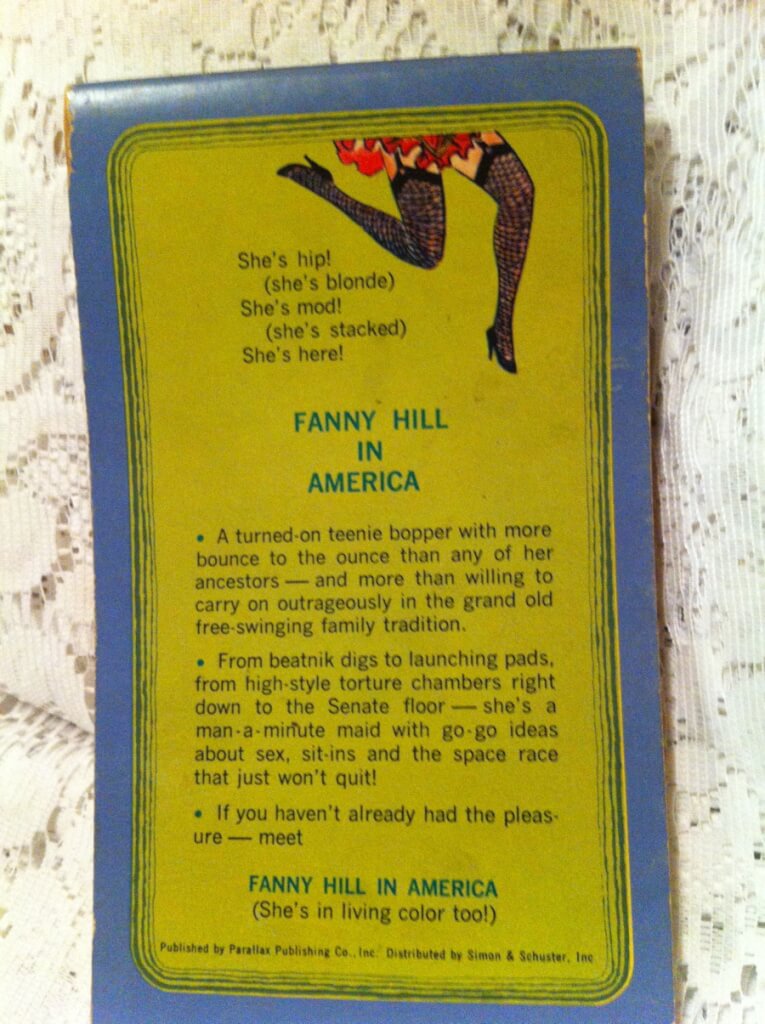
 Fanny Hill in America, by Frank Fosdick and David Sierra, cover by Jerry Schiano (Parallax Publishing Company, Inc, New York, Distributed by Simon & Schuster, Inc.) 7" x 4.25", soft cover comic book, cover scuffed and slightly soiled Stated "The first Go-Go Comic Novel in Full Color". As far as I can find it is the ONLY "Go-Go" Comic Novel. The Man from M.O.T.H.E.R. was also published in similar form saying "A Super-Cool Comic Novel in Full Color". Parallax is also hard to track down. I've only found mention of a few other comic books. all published in 1966 (The Great Society Comic Book[a parody of LBJ's social policies], it's companion comic, Bobman and Teddy [parodying Robert and Ted Kennedy], and the VERY rare Kosher Comics [featuring The Lone Arranger, Supermax, Tishman of the Apes, & Dick Shamus]). I can't find this publication listed at all. Other Parallax publications are similarly very rare.
Fanny Hill in America, by Frank Fosdick and David Sierra, cover by Jerry Schiano (Parallax Publishing Company, Inc, New York, Distributed by Simon & Schuster, Inc.) 7" x 4.25", soft cover comic book, cover scuffed and slightly soiled Stated "The first Go-Go Comic Novel in Full Color". As far as I can find it is the ONLY "Go-Go" Comic Novel. The Man from M.O.T.H.E.R. was also published in similar form saying "A Super-Cool Comic Novel in Full Color". Parallax is also hard to track down. I've only found mention of a few other comic books. all published in 1966 (The Great Society Comic Book[a parody of LBJ's social policies], it's companion comic, Bobman and Teddy [parodying Robert and Ted Kennedy], and the VERY rare Kosher Comics [featuring The Lone Arranger, Supermax, Tishman of the Apes, & Dick Shamus]). I can't find this publication listed at all. Other Parallax publications are similarly very rare. -
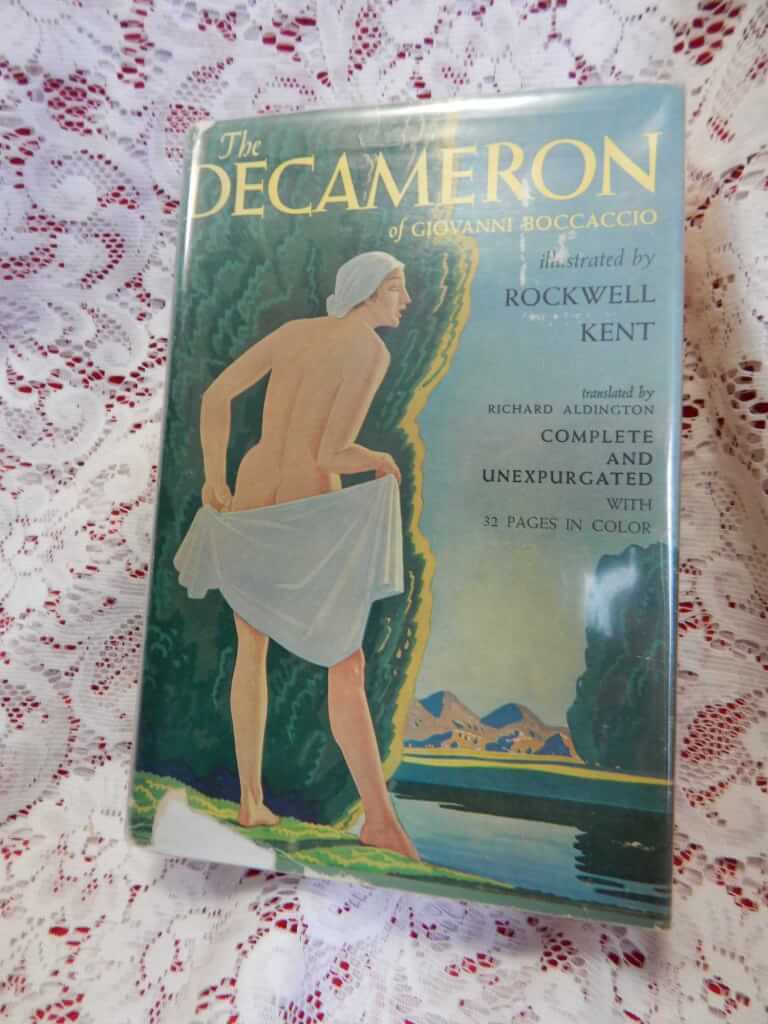
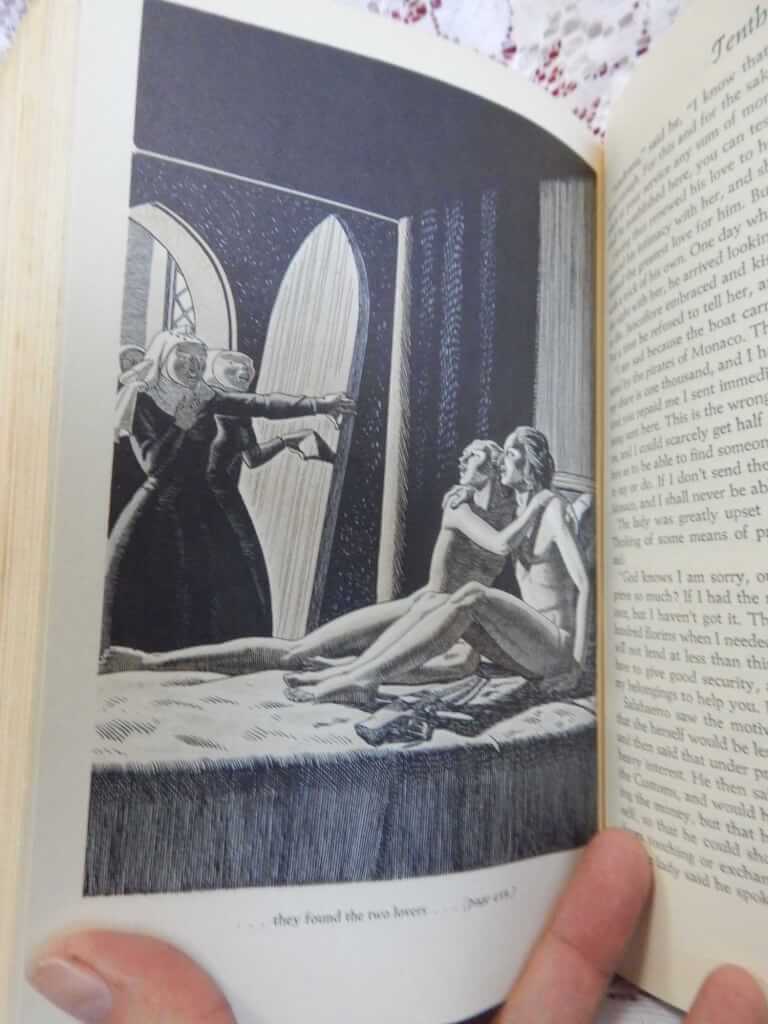 The Decameron of Giovanni Boccaccio, Giovanni Boccaccio, trans. Richard Aldington, illustrated by Rockwell Kent (Garden City Books, Garden City, NY, 1949 [date of illustrations]) 9 1/2" X 6 3/8", 562pp, hardbound with DJ (with some rips) protected by mylar, green boards with cream spine, great condition. This is the popular (at the time) Garden City edition. Superb art deco color illustrations throughout by Rockwell Kent (famous illustrator of Moby Dick and others). The Decameron, (subtitled Prencipe Galeotto or Prince Galehaut), is a collection of novellas by the 14th-century Italian author Giovanni Boccaccio (1313–1375). The book is structured as a frame story containing 100 tales told by a group of seven young women and three young men sheltering in a secluded villa just outside Florence to escape the Black Death, which was afflicting the city. To make their exile more pleasant each of the ten tells the others one story every day. The Decameron records the narratives of ten days -- 100 stories. Boccaccio probably conceived of The Decameron after the epidemic of 1348, and completed it by 1353. These tales run the entire range of human emotion: grief, love, humor, anger, revenge. Many are based on oral folklore. Boccaccio's ten narrators thus retell already familiar stories about errant priests, rascally husbands, and mischievous wives. Variants of these stories are known in many cultures, but no one formulates them more cleverly or relates them more eloquently than does Boccaccio. In addition to its literary value and widespread influence, it provides a document of life at the time. Written in the vernacular of the Florentine language, it is considered a masterpiece of classical early Italian prose.
The Decameron of Giovanni Boccaccio, Giovanni Boccaccio, trans. Richard Aldington, illustrated by Rockwell Kent (Garden City Books, Garden City, NY, 1949 [date of illustrations]) 9 1/2" X 6 3/8", 562pp, hardbound with DJ (with some rips) protected by mylar, green boards with cream spine, great condition. This is the popular (at the time) Garden City edition. Superb art deco color illustrations throughout by Rockwell Kent (famous illustrator of Moby Dick and others). The Decameron, (subtitled Prencipe Galeotto or Prince Galehaut), is a collection of novellas by the 14th-century Italian author Giovanni Boccaccio (1313–1375). The book is structured as a frame story containing 100 tales told by a group of seven young women and three young men sheltering in a secluded villa just outside Florence to escape the Black Death, which was afflicting the city. To make their exile more pleasant each of the ten tells the others one story every day. The Decameron records the narratives of ten days -- 100 stories. Boccaccio probably conceived of The Decameron after the epidemic of 1348, and completed it by 1353. These tales run the entire range of human emotion: grief, love, humor, anger, revenge. Many are based on oral folklore. Boccaccio's ten narrators thus retell already familiar stories about errant priests, rascally husbands, and mischievous wives. Variants of these stories are known in many cultures, but no one formulates them more cleverly or relates them more eloquently than does Boccaccio. In addition to its literary value and widespread influence, it provides a document of life at the time. Written in the vernacular of the Florentine language, it is considered a masterpiece of classical early Italian prose. -
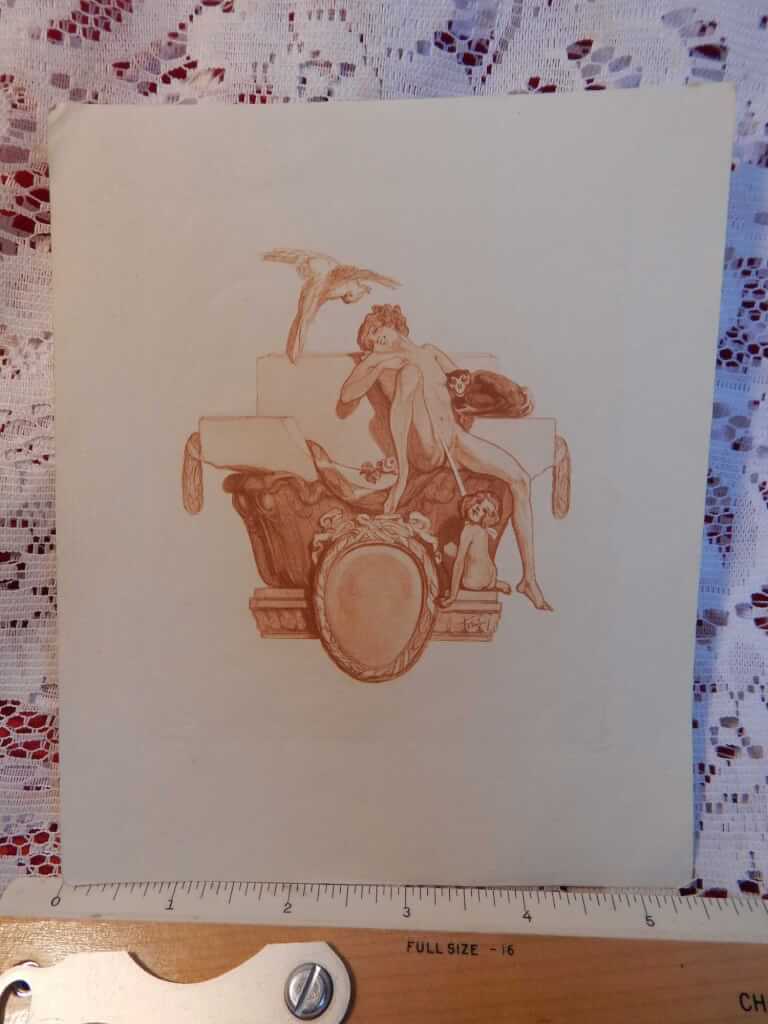 bookplate, by Franz von Bayros paper size 5.5 x 6.5", print size 4 x 4.5", on hand laid paper naked girl, animals, and child Franz von Bayros (1866 – 1924) was an Austrian commercial artist, illustrator, and painter, now he is best known for his erotic work. He belonged to the Decadent movement in art, often utilizing erotic themes and phantasmagoric imagery. At the age 17, Bayros passed the entrance exam for the Vienna Academy with Eduard von Engerth. Bayros mixed in elegant society and soon belonged to the circle of friends of Johann Straub, whose step daughter Alice he married on 1896. The next year, Bayros moved to Munich. In 1904, Bayros gave his first exhibition in Munich, which was a great success. From 1904 until 1908, Bayros traveled to Paris and Italy for his studies. Typically, for an artist dealing with such imagery, von Bayros produced work under several pseudonyms, most notably Choisy Le Conin, and was hounded by authorities for much of his life for his “indecent” art often very imaginative, and including such taboo subjects as sadomasochism and bestiality. He became equally well-known for his masterly drawn figures of elegant modestly nude and non-nude women.
bookplate, by Franz von Bayros paper size 5.5 x 6.5", print size 4 x 4.5", on hand laid paper naked girl, animals, and child Franz von Bayros (1866 – 1924) was an Austrian commercial artist, illustrator, and painter, now he is best known for his erotic work. He belonged to the Decadent movement in art, often utilizing erotic themes and phantasmagoric imagery. At the age 17, Bayros passed the entrance exam for the Vienna Academy with Eduard von Engerth. Bayros mixed in elegant society and soon belonged to the circle of friends of Johann Straub, whose step daughter Alice he married on 1896. The next year, Bayros moved to Munich. In 1904, Bayros gave his first exhibition in Munich, which was a great success. From 1904 until 1908, Bayros traveled to Paris and Italy for his studies. Typically, for an artist dealing with such imagery, von Bayros produced work under several pseudonyms, most notably Choisy Le Conin, and was hounded by authorities for much of his life for his “indecent” art often very imaginative, and including such taboo subjects as sadomasochism and bestiality. He became equally well-known for his masterly drawn figures of elegant modestly nude and non-nude women. -

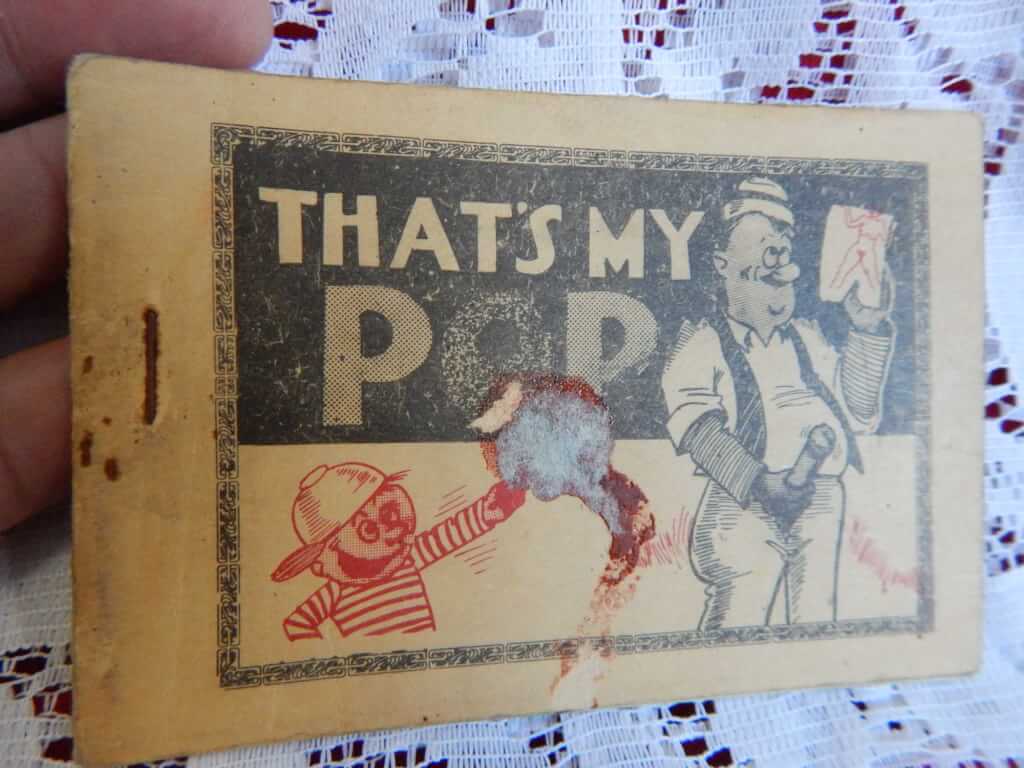 That's My Pop, (np. nd.) 4.5" x 3", 8pp.+2 pages describing sexual positions, pamphlet, stapled Tijuana bibles (also known as eight-pagers, bluesies, gray-backs, Jiggs-and-Maggie books, jo-jo books, Tillie-and-Mac books, and two-by-fours) were little pornographic comic books produced in the United States from the 1920s to the early 1960s.
That's My Pop, (np. nd.) 4.5" x 3", 8pp.+2 pages describing sexual positions, pamphlet, stapled Tijuana bibles (also known as eight-pagers, bluesies, gray-backs, Jiggs-and-Maggie books, jo-jo books, Tillie-and-Mac books, and two-by-fours) were little pornographic comic books produced in the United States from the 1920s to the early 1960s. -
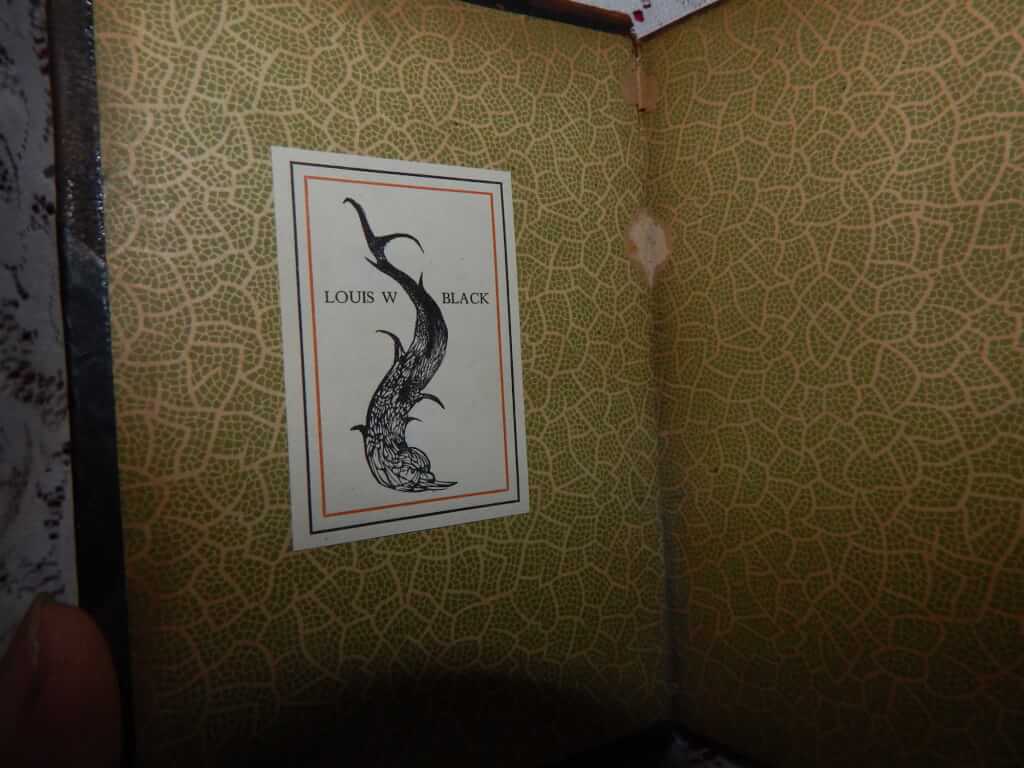
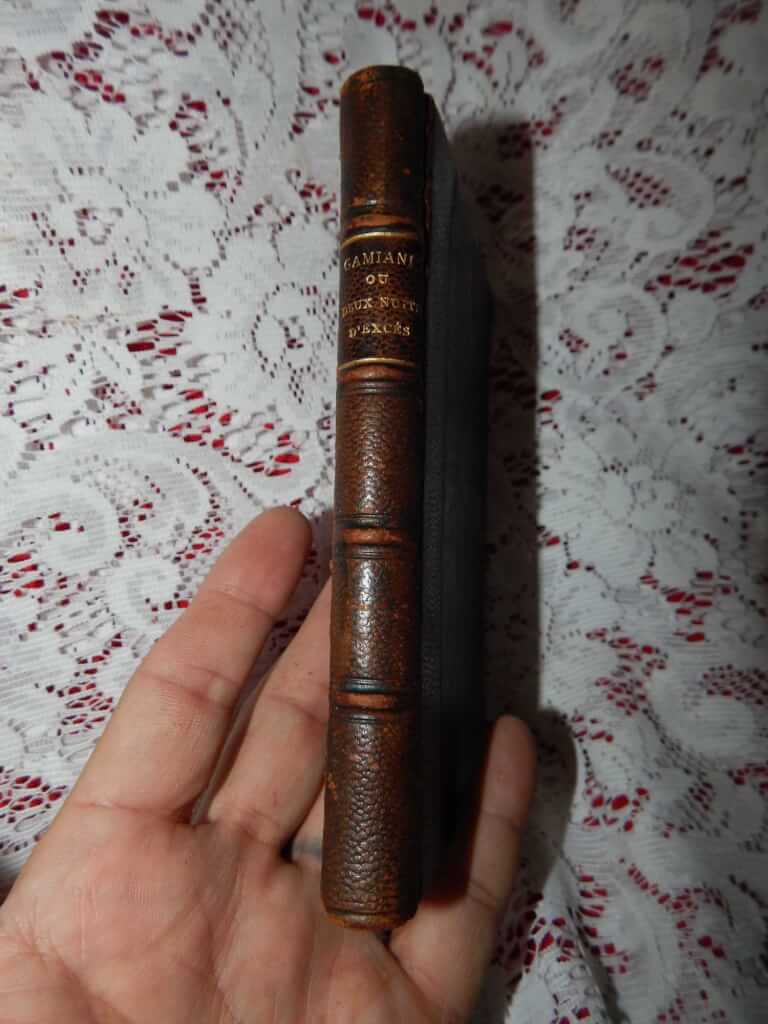 Gamiani, ou deux nuits d'excés par Alcide, Baron de M***, anonymous [believed to have been written by Alfred de Musset] (G. Lebaucher, Libraire-Éditeur, Montreal, Canada [likely Gaucher, Malakoff, France] nd.) 4.5"x6", 144pp, half morocco over marbled boards, title in gilt on spine, 4 raised bands, boards cracked but holding, just good condition Gamiani, or Two Nights of Excess is a French erotic novel first published in 1833. Its authorship is anonymous, but it is believed to have been written by Alfred de Musset and the lesbian eponymous heroine a portrait of his lover, George Sand. It became a bestseller among nineteenth century erotic literature. Modeled after George Sand, this work gives us a young man named Alcide observing the Countess Gamiani and a young girl named Fanny, engaged in their lesbian bed. Having watched them and provoked by their abandonment, he reveals himself, joins them, and they spend the night alternately sharing their intimate histories and their bodies. The stories they tell include the rape of one in a monastery and the nearly fatal debauchment of another in a convent, as well as encounters with a number of animals, including an ape and a donkey. Elias Gaucher (publisher from 1898 until 1925(?)) was a Clandestine editor who mainly used the pseudonym G. Lebaucher, Libraire-Éditeur, Montreal (Canada), but also Maison Mystère, Imprimerie Galante, etc. This publisher published many erotic underground works in English from 1898 to about 1904 with the mentions "Printed for the Erotica Biblion Society of London and New York", he also published erotic texts in French from 1899. His printing press was actually located at 11 rue Danicourt in Malakoff, France. Gaucher left his works in deposit with booksellers-distributors [...] Most editions of Gaucher are counterfeit editions of Brancart or Hirsch, and Gaucher often republished his own works.
Gamiani, ou deux nuits d'excés par Alcide, Baron de M***, anonymous [believed to have been written by Alfred de Musset] (G. Lebaucher, Libraire-Éditeur, Montreal, Canada [likely Gaucher, Malakoff, France] nd.) 4.5"x6", 144pp, half morocco over marbled boards, title in gilt on spine, 4 raised bands, boards cracked but holding, just good condition Gamiani, or Two Nights of Excess is a French erotic novel first published in 1833. Its authorship is anonymous, but it is believed to have been written by Alfred de Musset and the lesbian eponymous heroine a portrait of his lover, George Sand. It became a bestseller among nineteenth century erotic literature. Modeled after George Sand, this work gives us a young man named Alcide observing the Countess Gamiani and a young girl named Fanny, engaged in their lesbian bed. Having watched them and provoked by their abandonment, he reveals himself, joins them, and they spend the night alternately sharing their intimate histories and their bodies. The stories they tell include the rape of one in a monastery and the nearly fatal debauchment of another in a convent, as well as encounters with a number of animals, including an ape and a donkey. Elias Gaucher (publisher from 1898 until 1925(?)) was a Clandestine editor who mainly used the pseudonym G. Lebaucher, Libraire-Éditeur, Montreal (Canada), but also Maison Mystère, Imprimerie Galante, etc. This publisher published many erotic underground works in English from 1898 to about 1904 with the mentions "Printed for the Erotica Biblion Society of London and New York", he also published erotic texts in French from 1899. His printing press was actually located at 11 rue Danicourt in Malakoff, France. Gaucher left his works in deposit with booksellers-distributors [...] Most editions of Gaucher are counterfeit editions of Brancart or Hirsch, and Gaucher often republished his own works. -
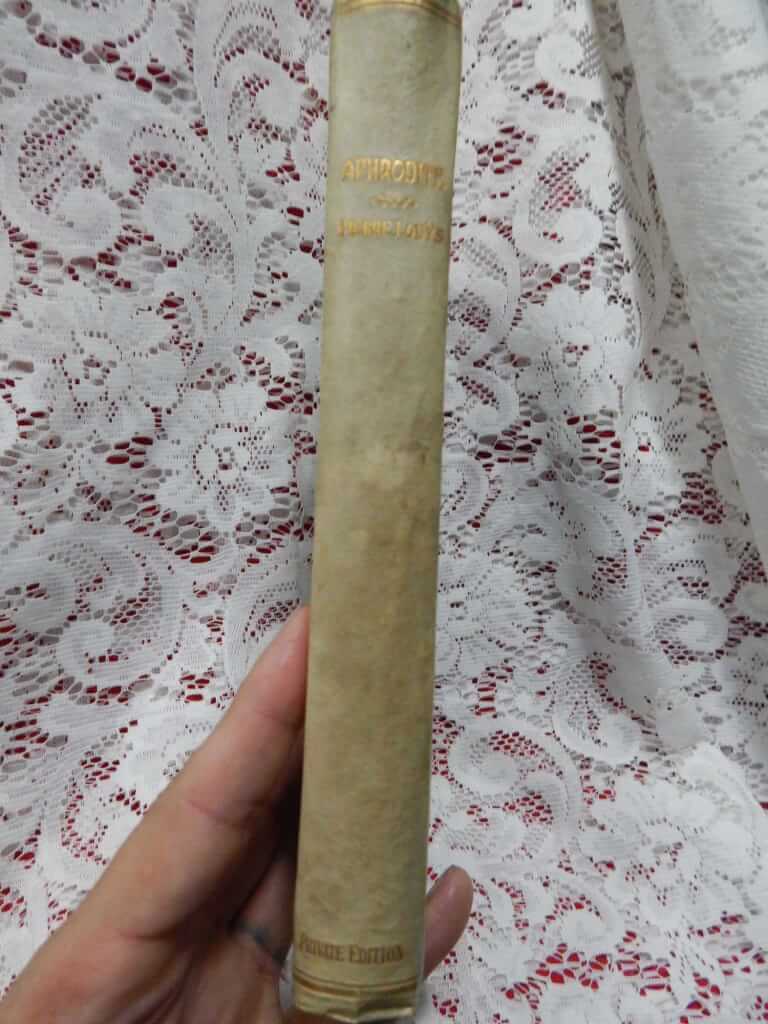
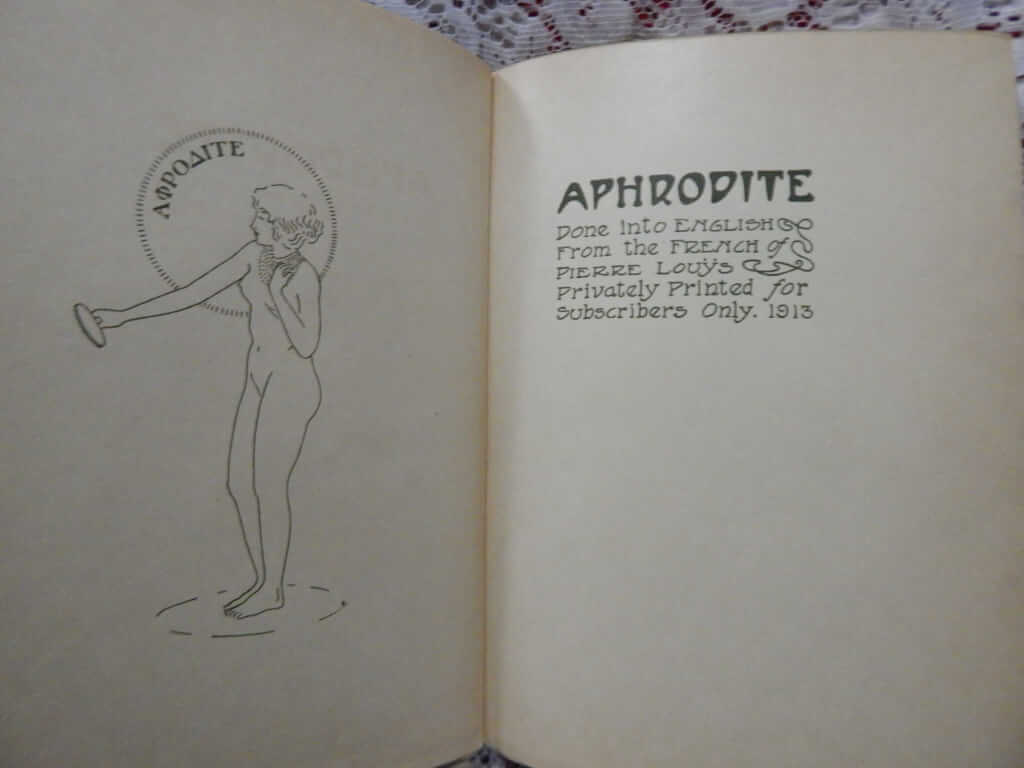 Aphrodite, done into English from the French of Pierre Louys, by Pierre Louÿs, illus. unknown, (Privately Printed for Subscribers Only[Mitchell S. Buck], 1913, #66/550) 6.5"x8.75", xi+258pp+Notes+Index, cream vellum spine over green boards, gilt titles on spine, good condition, some bumping and rubbing Buck's translation is easier to read than Carrington's translation a few years earlier. This was his first book, most likely, self-published and printed by Nicholas L. Brown. Pierre Louys (1870 - 1925) was a French poet and writer, most renowned for lesbian and classical themes in some of his writings. He is known as a writer who "expressed pagan sensuality with stylistic perfection." "Aphrodite: mæurs antiques" (Ancient Manners) is a "libertine" story set in ancient Alexandria. Highlights include the loves of Chrysis, an orgy banquet ending in the crucifixion of a slave, the love of two young musician girls and the festivals of Aphrodite." Mitchell Starrett Buck (February 10, 1887 – May 12, 1959) was an American poet, translator and classical scholar. His volumes of verse and prose poetry were deeply influenced by 1890s aestheticism as well as classical Greek and Roman Literature. Buck’s writing was secondary to his work as a heating engineer, and the money he made professionally allowed him to become a noted book-collector, specializing in first editions, English literature, Greek and Latin classics. Buck’s first book was a translation of Aphrodite by the French decadent Pierre Louÿs (1870-1925). It appeared in 1913, and was “privately printed”, probably at Buck’s expense. It may have been arranged through the Philadelphia bookseller Nicholas L. Brown, who officially became a publisher in 1916, and thereafter issued most of Buck’s output. Between 1916 and 1932, Brown published small editions of poetry, belles lettres, translations, sometimes without his imprint but stating that the title has been “issued privately for subscribers” (in order to evade prosecution for dealing in obscene materials). Such classical erotica is very tame by modern standards, but in the teens and twenties such material was policed by self-appointed authorities such as John S. Sumner of the New York Society for the Suppression of Vice.
Aphrodite, done into English from the French of Pierre Louys, by Pierre Louÿs, illus. unknown, (Privately Printed for Subscribers Only[Mitchell S. Buck], 1913, #66/550) 6.5"x8.75", xi+258pp+Notes+Index, cream vellum spine over green boards, gilt titles on spine, good condition, some bumping and rubbing Buck's translation is easier to read than Carrington's translation a few years earlier. This was his first book, most likely, self-published and printed by Nicholas L. Brown. Pierre Louys (1870 - 1925) was a French poet and writer, most renowned for lesbian and classical themes in some of his writings. He is known as a writer who "expressed pagan sensuality with stylistic perfection." "Aphrodite: mæurs antiques" (Ancient Manners) is a "libertine" story set in ancient Alexandria. Highlights include the loves of Chrysis, an orgy banquet ending in the crucifixion of a slave, the love of two young musician girls and the festivals of Aphrodite." Mitchell Starrett Buck (February 10, 1887 – May 12, 1959) was an American poet, translator and classical scholar. His volumes of verse and prose poetry were deeply influenced by 1890s aestheticism as well as classical Greek and Roman Literature. Buck’s writing was secondary to his work as a heating engineer, and the money he made professionally allowed him to become a noted book-collector, specializing in first editions, English literature, Greek and Latin classics. Buck’s first book was a translation of Aphrodite by the French decadent Pierre Louÿs (1870-1925). It appeared in 1913, and was “privately printed”, probably at Buck’s expense. It may have been arranged through the Philadelphia bookseller Nicholas L. Brown, who officially became a publisher in 1916, and thereafter issued most of Buck’s output. Between 1916 and 1932, Brown published small editions of poetry, belles lettres, translations, sometimes without his imprint but stating that the title has been “issued privately for subscribers” (in order to evade prosecution for dealing in obscene materials). Such classical erotica is very tame by modern standards, but in the teens and twenties such material was policed by self-appointed authorities such as John S. Sumner of the New York Society for the Suppression of Vice. -
 Venus in Furs, Leopold von Sacher-Masoch, trans. Fernanda Savage (Privately Printed For Subscirbers Only. 1921, [first english translation?] limited first edition thus, #400/1225) Venus in Furs (German: Venus im Pelz) is a novella by Leopold Ritter von Sacher-Masoch (1836-1895), an Austrian writer and journalist. It is now his best known work and because of its themes the term masochism is derived from his name, coined by the Austrian psychiatrist, Krafft-Ebing. The novel was to be part of an epic series that Sacher-Masoch envisioned called Legacy of Cain. Venus in Furs was part of Love, the first volume of the series. It was published in 1870. The novel draws themes, like female dominance and sadomasochism, and character inspiration heavily from Sacher-Masoch's own life. Wanda von Dunajew, the novel's central female character, was modelled after his mistress Baroness Fanny Pistor. In December 1869 the two signed a contract making him her slave for a period of 6 months. In 1873, after the publication of Venus in Furs, Sacher-Masoch married Aurora von Rümelin who he pressured to continue the lifestyle he wrote about in his book. After 10 years they divorced. Rümelin, using the pseudonym of the books title character, "Wanda von Dunajew", wrote Meine Lebensbeichte (My Life Confession) published in 1906. It detailed Sacher-Masoch's private life and her relationship with him. During his lifetime, Sacher-Masoch was well known as a man of letters, a utopian thinker who espoused socialist and humanist ideals in his fiction and non-fiction. Most of his works remain untranslated into English. Until recently, his novel Venus in Furs was his only book commonly available in English.
Venus in Furs, Leopold von Sacher-Masoch, trans. Fernanda Savage (Privately Printed For Subscirbers Only. 1921, [first english translation?] limited first edition thus, #400/1225) Venus in Furs (German: Venus im Pelz) is a novella by Leopold Ritter von Sacher-Masoch (1836-1895), an Austrian writer and journalist. It is now his best known work and because of its themes the term masochism is derived from his name, coined by the Austrian psychiatrist, Krafft-Ebing. The novel was to be part of an epic series that Sacher-Masoch envisioned called Legacy of Cain. Venus in Furs was part of Love, the first volume of the series. It was published in 1870. The novel draws themes, like female dominance and sadomasochism, and character inspiration heavily from Sacher-Masoch's own life. Wanda von Dunajew, the novel's central female character, was modelled after his mistress Baroness Fanny Pistor. In December 1869 the two signed a contract making him her slave for a period of 6 months. In 1873, after the publication of Venus in Furs, Sacher-Masoch married Aurora von Rümelin who he pressured to continue the lifestyle he wrote about in his book. After 10 years they divorced. Rümelin, using the pseudonym of the books title character, "Wanda von Dunajew", wrote Meine Lebensbeichte (My Life Confession) published in 1906. It detailed Sacher-Masoch's private life and her relationship with him. During his lifetime, Sacher-Masoch was well known as a man of letters, a utopian thinker who espoused socialist and humanist ideals in his fiction and non-fiction. Most of his works remain untranslated into English. Until recently, his novel Venus in Furs was his only book commonly available in English. -
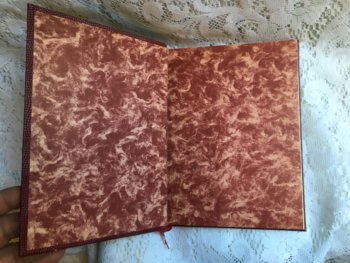
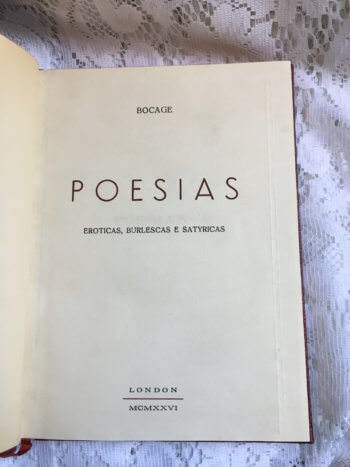 Poesias: eroticas, burlescas e satyricas, Bocage (Manuel Maria Barbosa du Bocage) (np, London, 1926, #443/1000 machine numbered) 6" X 8", 220pp, in Portuguese, hardcover, quarter bound red leather over red pebbled boards, gilt titles and decorations on spine, four raised bands, laid paper, top-edge inked, marbled end papers, ribbon present, a handsome quarter-leather bound copy of a clandestinely published edition of Bocage's unpublishable works. (most copies of this edition are softbound). Manuel Maria Barbosa du Bocage (1765-1805) was a Portuguese Neoclassic poet, writing at the beginning of his career under the pen name Elmano Sadino. He aspired to be a second Camões. He was born, the son of a lawyer, in Setúbal, Portugal. He is said to to have made verses in infancy, and being somewhat of a prodigy grew up to be flattered, self-conscious and unstable. He left home at age 14 to join the army then transfered to the navy at age 16. While in the military he devoted most of his energies to love affairs, poetry, and bohemianism. Eventually, like his hero Camões, he was sent to India and became disillusioned by the Orient. He deserted to Macau, returning to Lisbon in 1790. He then joined the New Arcadia, a literary society with vaguely egalitarian and libertarian sympathies, but his satires on his fellow members resulted in his expulsion. In 1797 he was accused of propagating republicanism and atheism and was imprisoned. During his imprisonment he undertook translations of Virgil and Ovid. Translations provided him with a livelihood during the few years that he lived after his release. Despite the Neoclassical framework of his poetry, his intensely personal accent, frequent violence of expression, and self-dramatizing obsession with fate and death anticipate Romanticism. The subversiveness of his poems has meant that for much of the last 200 years they have not been (officially) available in Portugal.
Poesias: eroticas, burlescas e satyricas, Bocage (Manuel Maria Barbosa du Bocage) (np, London, 1926, #443/1000 machine numbered) 6" X 8", 220pp, in Portuguese, hardcover, quarter bound red leather over red pebbled boards, gilt titles and decorations on spine, four raised bands, laid paper, top-edge inked, marbled end papers, ribbon present, a handsome quarter-leather bound copy of a clandestinely published edition of Bocage's unpublishable works. (most copies of this edition are softbound). Manuel Maria Barbosa du Bocage (1765-1805) was a Portuguese Neoclassic poet, writing at the beginning of his career under the pen name Elmano Sadino. He aspired to be a second Camões. He was born, the son of a lawyer, in Setúbal, Portugal. He is said to to have made verses in infancy, and being somewhat of a prodigy grew up to be flattered, self-conscious and unstable. He left home at age 14 to join the army then transfered to the navy at age 16. While in the military he devoted most of his energies to love affairs, poetry, and bohemianism. Eventually, like his hero Camões, he was sent to India and became disillusioned by the Orient. He deserted to Macau, returning to Lisbon in 1790. He then joined the New Arcadia, a literary society with vaguely egalitarian and libertarian sympathies, but his satires on his fellow members resulted in his expulsion. In 1797 he was accused of propagating republicanism and atheism and was imprisoned. During his imprisonment he undertook translations of Virgil and Ovid. Translations provided him with a livelihood during the few years that he lived after his release. Despite the Neoclassical framework of his poetry, his intensely personal accent, frequent violence of expression, and self-dramatizing obsession with fate and death anticipate Romanticism. The subversiveness of his poems has meant that for much of the last 200 years they have not been (officially) available in Portugal. -
Out of stock
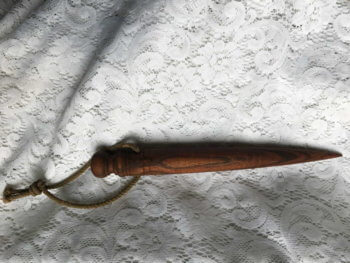
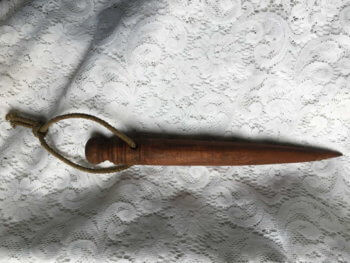 Fid from India 13.5" long, 1.5" at widest part, unknown wood, with original rope A fid is a conical tool made of wood or bone. It is used to work with rope and canvas in seamanship. A fid is used to hold open knots and holes in canvas or to open the "lays", or strands of rope, for splicing.
Fid from India 13.5" long, 1.5" at widest part, unknown wood, with original rope A fid is a conical tool made of wood or bone. It is used to work with rope and canvas in seamanship. A fid is used to hold open knots and holes in canvas or to open the "lays", or strands of rope, for splicing. -
 The Love Books of Ovid, A Completely Unexpurgated and Newly Translated Edition by Charles D. Young | Together with the Elegie, Translated by Christopher Marlowe | Illustrated by Alexander King "This book, designed by T. Spencer Hutson, was printed at the Alexander Hamilton Press, in March 1930. Illustrations are reproduced by the Knudson process. This edition consists of Two Thousand numbered copies printed on Strathmore MELDON deckle edge laid paper. This copy is No. 361" (Privately Published for Subscribers, Art Studio Books, Inc., 1930, #361/2000) 6.25"x9.5", iii+302pp, 3/4 black cloth over marbled boards, gilt text and decorations on spine, gilt borders on covers, marbled pastdowns, top edge gilt, other edges deckled, frontispiece and 16 full-page illustrations with descriptive tissue guards, other illustrations and titles in orange within text, near fine copy, slight rubbing at top and bottom of spine. This is a beautiful edition of 5 of his works, Ars Amatoria ("The Art of Love"), Remedia Amoris ("The Cure for Love"), Amores ("The Loves"), Medicamina Faciei ("dye on the face"), and his Elegies Publius Ovidius Naso (43 BC – AD 17/18), known as Ovid in the English-speaking world, was a Roman poet who lived during the reign of Augustus. He was a contemporary of the older Virgil and Horace, with whom he is often ranked as one of the three canonical poets of Latin literature. The Imperial scholar Quintilian considered him the last of the Latin love elegists. He enjoyed enormous popularity, but, in one of the mysteries of literary history, was sent by Augustus into exile in a remote province on the Black Sea, where he remained until his death. Ovid himself attributes his exile to carmen et error, "a poem and a mistake", but his discretion in discussing the causes has resulted in much speculation among scholars. The first major Roman poet to begin his career during the reign of Augustus, Ovid is today best known for the Metamorphoses, a 15-book continuous mythological narrative written in the meter of epic, and for works in elegiac couplets such as Ars Amatoria ("The Art of Love") and Fasti. His poetry was much imitated during Late Antiquity and the Middle Ages, and greatly influenced Western art and literature. The Metamorphoses remains one of the most important sources of classical mythology. Alexander King (1899–1965), born Alexander Koenig in Vienna, was a bestselling humorist, memoirist and media personality of the early television era, based in the United States. In his late fifties, after becoming a frequent guest on the a Tonight Show hosted by Jack Paar, King emerged as an incongruous presence in the realm of national celebrity: an aging, irascible raconteur, with elegant mannerisms and trademark bow-tie, who spoke frankly and disarmingly about his bohemian lifestyle, multiple marriages, and years-long struggle with drug addiction. His checkered past led TIME magazine to describe him as "an ex-illustrator, ex-cartoonist, ex-adman, ex-editor, ex-playwright, ex-dope addict. For a quarter-century he was an ex-painter, and by his own bizarre account qualifies as an ex-midwife. He is also an ex-husband to three wives and an ex-Viennese of sufficient age (60) to remember muttonchopped Emperor Franz Joseph. When doctors told him a few years ago that he might soon be an ex-patient (two strokes, serious kidney disease, peptic ulcer, high blood pressure), he sat down to tell gay stories of the life of all these earlier Kings."
The Love Books of Ovid, A Completely Unexpurgated and Newly Translated Edition by Charles D. Young | Together with the Elegie, Translated by Christopher Marlowe | Illustrated by Alexander King "This book, designed by T. Spencer Hutson, was printed at the Alexander Hamilton Press, in March 1930. Illustrations are reproduced by the Knudson process. This edition consists of Two Thousand numbered copies printed on Strathmore MELDON deckle edge laid paper. This copy is No. 361" (Privately Published for Subscribers, Art Studio Books, Inc., 1930, #361/2000) 6.25"x9.5", iii+302pp, 3/4 black cloth over marbled boards, gilt text and decorations on spine, gilt borders on covers, marbled pastdowns, top edge gilt, other edges deckled, frontispiece and 16 full-page illustrations with descriptive tissue guards, other illustrations and titles in orange within text, near fine copy, slight rubbing at top and bottom of spine. This is a beautiful edition of 5 of his works, Ars Amatoria ("The Art of Love"), Remedia Amoris ("The Cure for Love"), Amores ("The Loves"), Medicamina Faciei ("dye on the face"), and his Elegies Publius Ovidius Naso (43 BC – AD 17/18), known as Ovid in the English-speaking world, was a Roman poet who lived during the reign of Augustus. He was a contemporary of the older Virgil and Horace, with whom he is often ranked as one of the three canonical poets of Latin literature. The Imperial scholar Quintilian considered him the last of the Latin love elegists. He enjoyed enormous popularity, but, in one of the mysteries of literary history, was sent by Augustus into exile in a remote province on the Black Sea, where he remained until his death. Ovid himself attributes his exile to carmen et error, "a poem and a mistake", but his discretion in discussing the causes has resulted in much speculation among scholars. The first major Roman poet to begin his career during the reign of Augustus, Ovid is today best known for the Metamorphoses, a 15-book continuous mythological narrative written in the meter of epic, and for works in elegiac couplets such as Ars Amatoria ("The Art of Love") and Fasti. His poetry was much imitated during Late Antiquity and the Middle Ages, and greatly influenced Western art and literature. The Metamorphoses remains one of the most important sources of classical mythology. Alexander King (1899–1965), born Alexander Koenig in Vienna, was a bestselling humorist, memoirist and media personality of the early television era, based in the United States. In his late fifties, after becoming a frequent guest on the a Tonight Show hosted by Jack Paar, King emerged as an incongruous presence in the realm of national celebrity: an aging, irascible raconteur, with elegant mannerisms and trademark bow-tie, who spoke frankly and disarmingly about his bohemian lifestyle, multiple marriages, and years-long struggle with drug addiction. His checkered past led TIME magazine to describe him as "an ex-illustrator, ex-cartoonist, ex-adman, ex-editor, ex-playwright, ex-dope addict. For a quarter-century he was an ex-painter, and by his own bizarre account qualifies as an ex-midwife. He is also an ex-husband to three wives and an ex-Viennese of sufficient age (60) to remember muttonchopped Emperor Franz Joseph. When doctors told him a few years ago that he might soon be an ex-patient (two strokes, serious kidney disease, peptic ulcer, high blood pressure), he sat down to tell gay stories of the life of all these earlier Kings." -
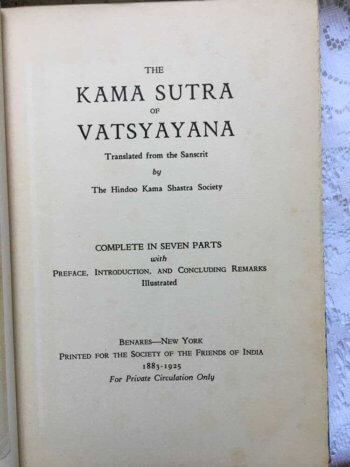
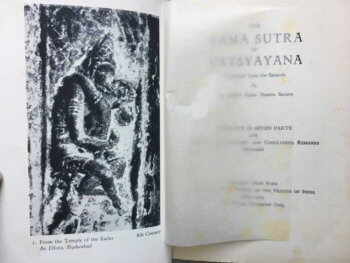 <strong>The Kama Sutra of Vatsyayana | Translated from the Sanscrit by The Hindoo Kama Shastra Society | Complete in seven parts with Preface, Introduction, and Concluding Remarks | Illustrated</strong>, by Vatsyayana (Printed for the Society of the Friends of India 1883-1925, Benares-New York, one of 800, unnumbered) <em>6"x9", xxi+175pp, hardbound, blue boards, hand laid paper, top-edge gilt, others deckled, 8 B/W half-tone reproductions of erotic Hindu stone-sculptures with tissue guards, soiling on boards, inner pages are clean, binding is good.</em> Attributed to ancient Indian philosopher Vatsyayana, the Kama Sutra is generally believed to have been composed between 400 and 200 B.C.E. Although a portion of the work consists of practical advice on sexual intercourse, the work is primarily prose consisting of 1250 verses distributed over 36 chapters structured into seven parts. This book lists those parts as: Part I. Index, and General Consideration of the Subject Part II. Of Sexual Union Part III. About the Acquisition of a Wife Part IV. About a Wife Part V. About the Wives of Other People Part VI. About Courtezans Part VII. On the Means of Attracting Others to Oneself
<strong>The Kama Sutra of Vatsyayana | Translated from the Sanscrit by The Hindoo Kama Shastra Society | Complete in seven parts with Preface, Introduction, and Concluding Remarks | Illustrated</strong>, by Vatsyayana (Printed for the Society of the Friends of India 1883-1925, Benares-New York, one of 800, unnumbered) <em>6"x9", xxi+175pp, hardbound, blue boards, hand laid paper, top-edge gilt, others deckled, 8 B/W half-tone reproductions of erotic Hindu stone-sculptures with tissue guards, soiling on boards, inner pages are clean, binding is good.</em> Attributed to ancient Indian philosopher Vatsyayana, the Kama Sutra is generally believed to have been composed between 400 and 200 B.C.E. Although a portion of the work consists of practical advice on sexual intercourse, the work is primarily prose consisting of 1250 verses distributed over 36 chapters structured into seven parts. This book lists those parts as: Part I. Index, and General Consideration of the Subject Part II. Of Sexual Union Part III. About the Acquisition of a Wife Part IV. About a Wife Part V. About the Wives of Other People Part VI. About Courtezans Part VII. On the Means of Attracting Others to Oneself














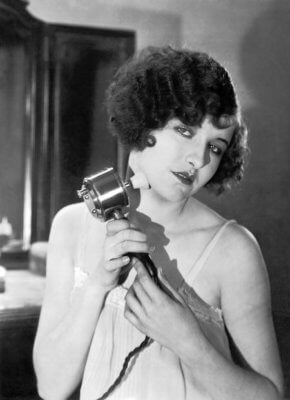 c. 1927 Actress Colleen Moore using a Star-Rite electric massage vibrator in Hollywood.
c. 1927 Actress Colleen Moore using a Star-Rite electric massage vibrator in Hollywood. 


